Results 21 to 40 of 76
Thread: 1971 Pontiac Lemans Convertible
-
09-03-2012 #21
 Registered User
Registered User
- Join Date
- Nov 2011
- Location
- Springfield, OH
- Posts
- 58
This post will document the transmission crossmember I made. I first tried to modify the Pontiac cross member but found it wouldn't have been feasible. I also considered buying a Chevelle cross member and doing the easy typical mod of flipping and re-welding the tab on, but didn't want to spend the money for a new one or spend time looking for a used one.
I was getting more comfortable with my welding skills so I decided to give this a go. I used metal angles and straps I found at Lowes. I decided to make it in three pieces, two small brackets that sit on top of the frame and the main cross member part. Height adjustments for driveline angles will be done between the frame brackets and main cross member.
The brackets are in the shape of a "Z", I tried to add strengthening braces to all parts as much as I could.
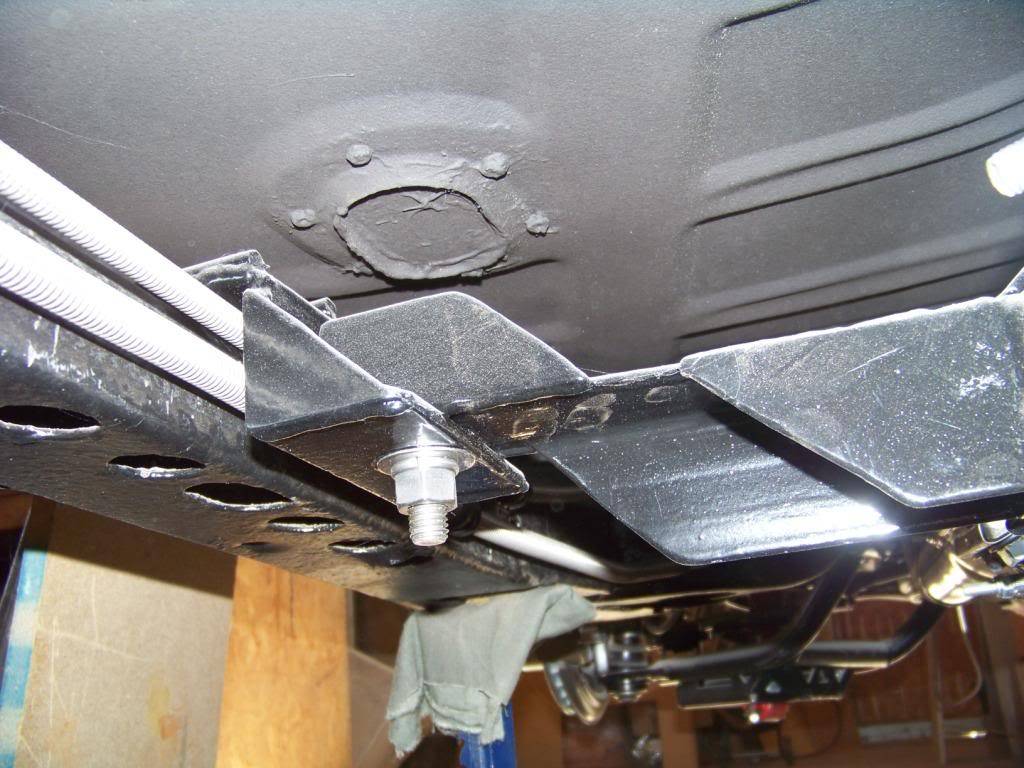
The main cross member was made of several pieces, here are views looking forward and aft:
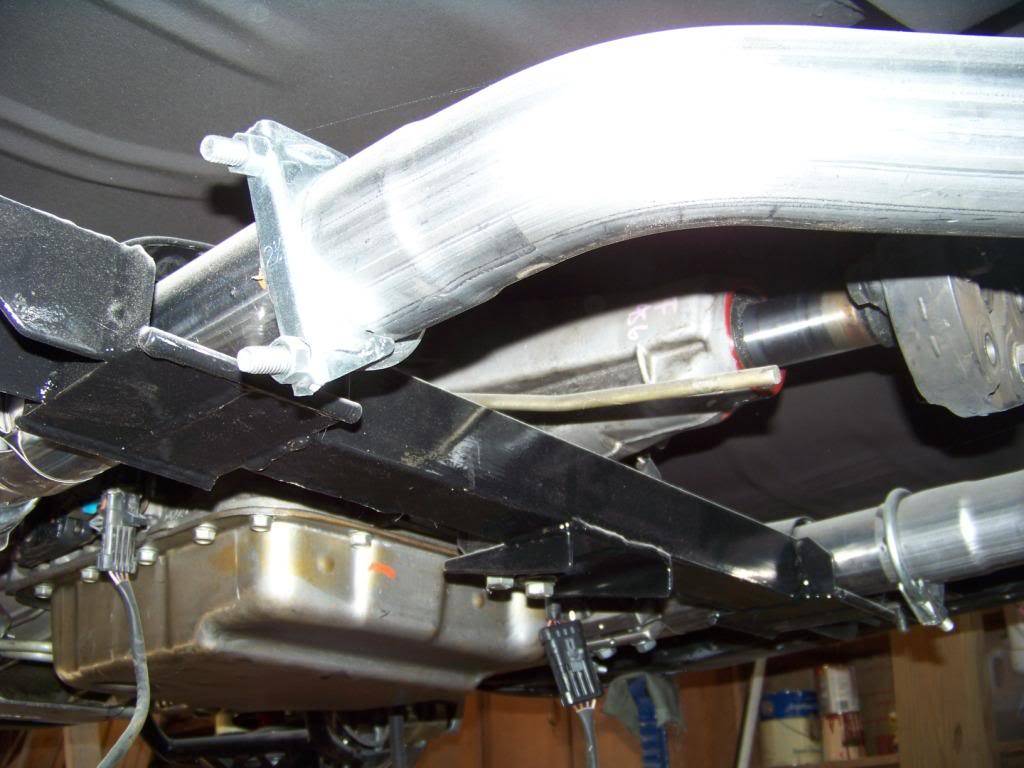
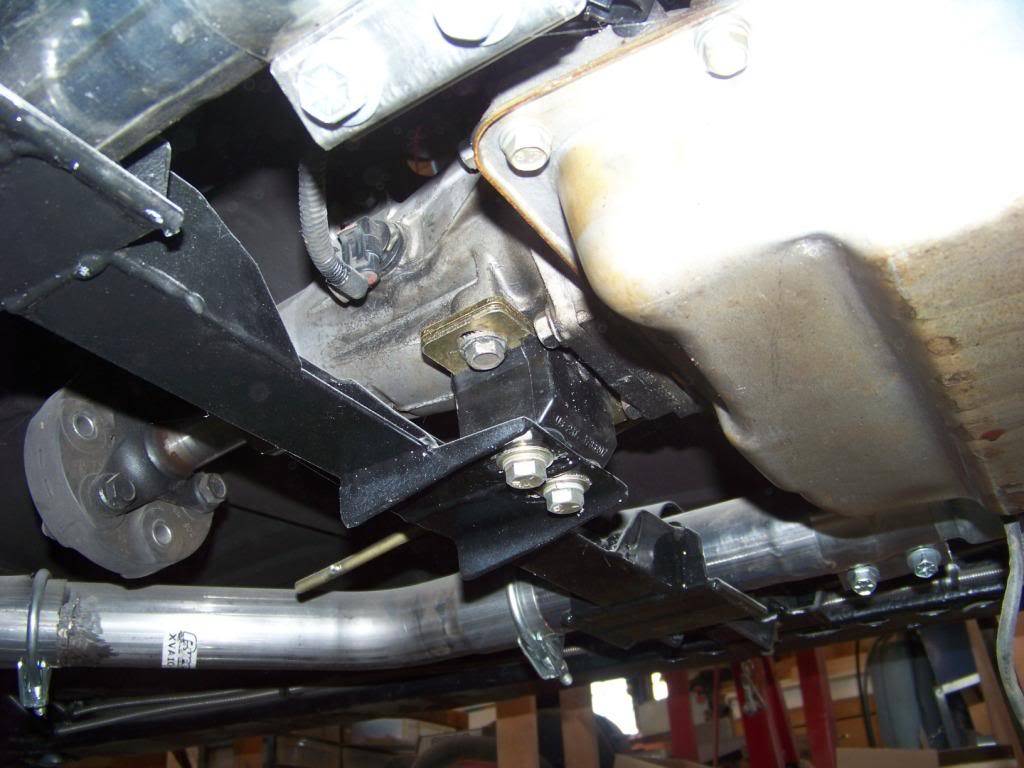
Not the prettiest thing in the world, but hopefully it works for awhile. Someday I will probably make another one that looks better.
Now next will be headers and exhaust.
-
09-03-2012 #22 Registered User
Registered User
- Join Date
- Nov 2011
- Location
- Springfield, OH
- Posts
- 58
As promised some info on the headers and exhaust:
After doing my usual "exhaustive" research I decided on Doug's LS1 swap Headers for A-bodies. I bought part number D3338, the ceramic coated ones. Amazon actually caries these, so I got a pretty good deal and free shipping. Inside the package was the headers, gaskets, bolts, 3" to 2 1/2" reducers, two clamps, and two O2 sensor extension harnesses. The headers have O2 bungs welded on the outside of each collector. They come wrapped in bubble wrap which I left on during installation to avoid scratches and dings. I installed these before the body went back on so they went on pretty easy.
These fit great in my situation, I have plenty of clearance everywhere. I should mention that I did move the brake distribution block from it's normal position on the inside of the frame to the top of the frame below the master cylinder, you can see that in the driver's side picture below. I knew from my research that this was a possible issue and it didn't really bother me too much as I was running new lines anyway and also adding an adjustable proportioning valve nearby.
One issue that I did have to deal with is that the O2 extension harnesses supplied by Dougs would not work with the engine wiring harness from the 04 GTO, apparently they use different connectors (square gray) than the F-body LS1 harnesses (square black). I did call Dougs about it and was just told to go buy the correct ones. I found and ordered the correct ones on ebay, they seem to work fine.
Another issue I had was that the original GM spark plug wires didn't fit very well around the header tubes in some cases. I decided to get a set of MSD -32813 spark plug wires, these have bendable spark plug boots so you can position the boot wires away from the headers as needed. These are also shown in the pictures below.
Here are pictures of the headers: Excuse the dust, been busy making cabinets lately and the dust goes everywhere.
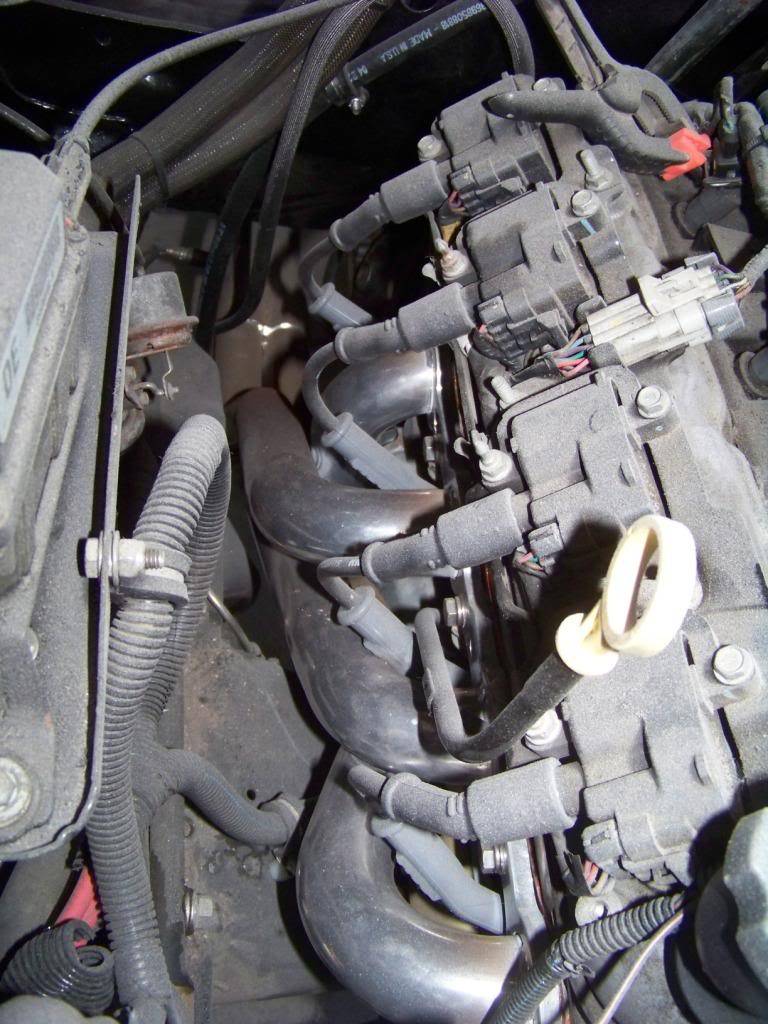
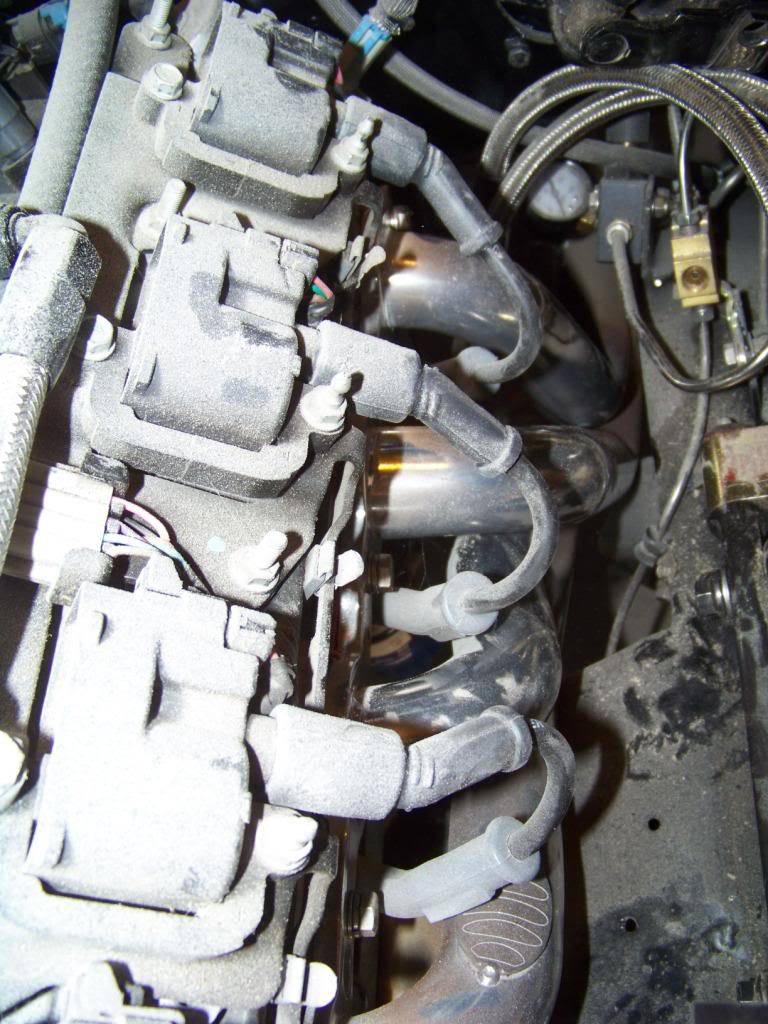
For exhaust I decided to go with the Pypes 2 1/2" system with x-pipe, part number PYE-SGA12S. I chose these because they seemed to have a fairly good reputation and are stainless steel for a reasonable price. The system comes with stainless hangers that are the same design as the original GM hangers. This system did require some mods to install, I end up trimming the four pipes forward and aft of the x-pipe as necessary to get everything to fit.
The Pypes kit comes with standard u-bolt style clamps, I did end up replacing some of these with stainless band clamps I got from Summit, part number WLK-33226.
This picture shows the driver's side header from underneath the car. You can see there is plenty of clearance between the header and floor, frame, and other parts. Also plenty of room to install the O2 sensor. The Pypes clamp was used to attach the reducer to the header collector and the band clamp I bought was used to attach the reducer to the exhaust. You can also see the Holley LS1 swap oil pan in this picture and how well it fits flush with the bottom on the engine crossmember.
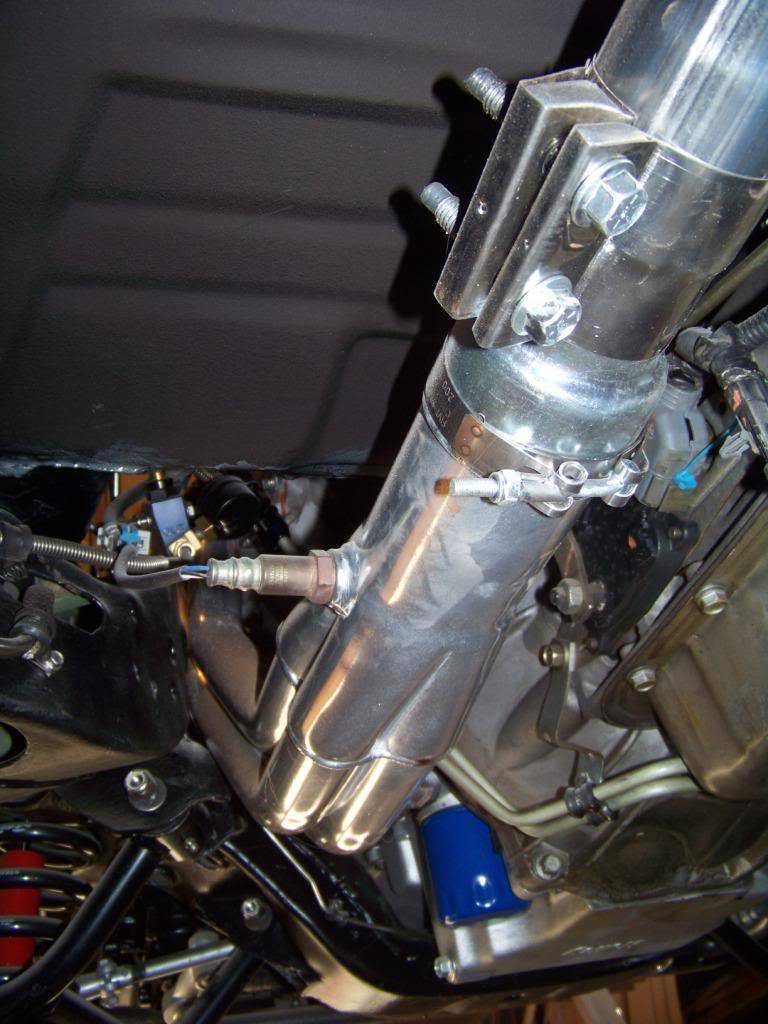
The picture below shows the x-pipe and mufflers installed. I positioned the clamps in such a way to avoid damage from speed bumps and to make the bolts accessible in the future.
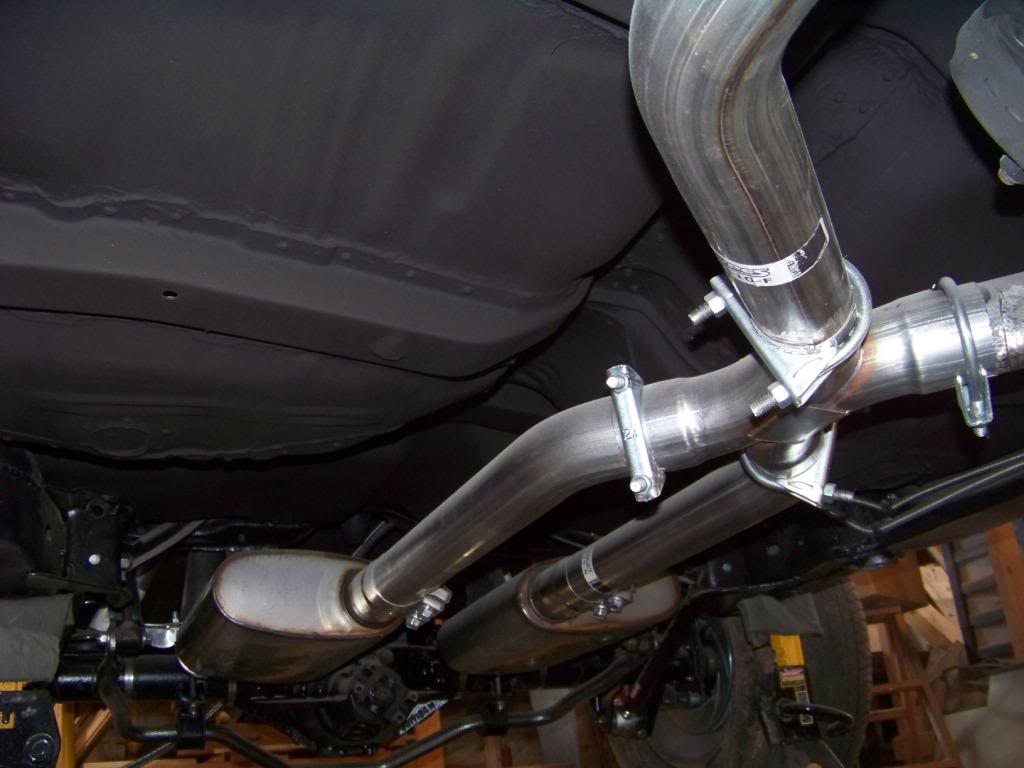
Now that I have installed as much as I can on the frame I can put the body back on, that will be the next update (the above pictures were taken after that).
10-21-2012 #23 Registered User
Registered User
- Join Date
- Nov 2011
- Location
- Springfield, OH
- Posts
- 58
Next step was to put the body back on the frame.
I just reversed the procedure when I removed the body - we rolled the rolltisserie back to horizontal and supported the body again with the concrete blocks and 2x4s as before. At this point the rolltisserie was removed from the body. The frame was rolled back under the body and I lowed the body back onto the frame, doing it gradually removing a 2x4 spacer at each corner at a time so the body wouldn't get twisted. As I got closer I lined up the frame under the body so the body bolt holes would line up.
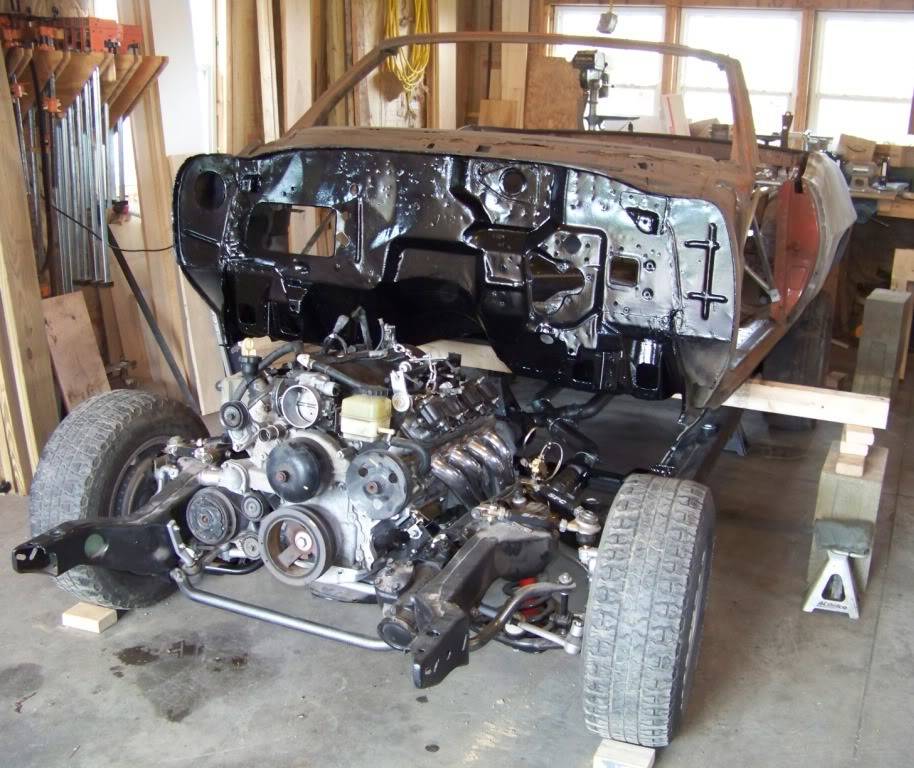
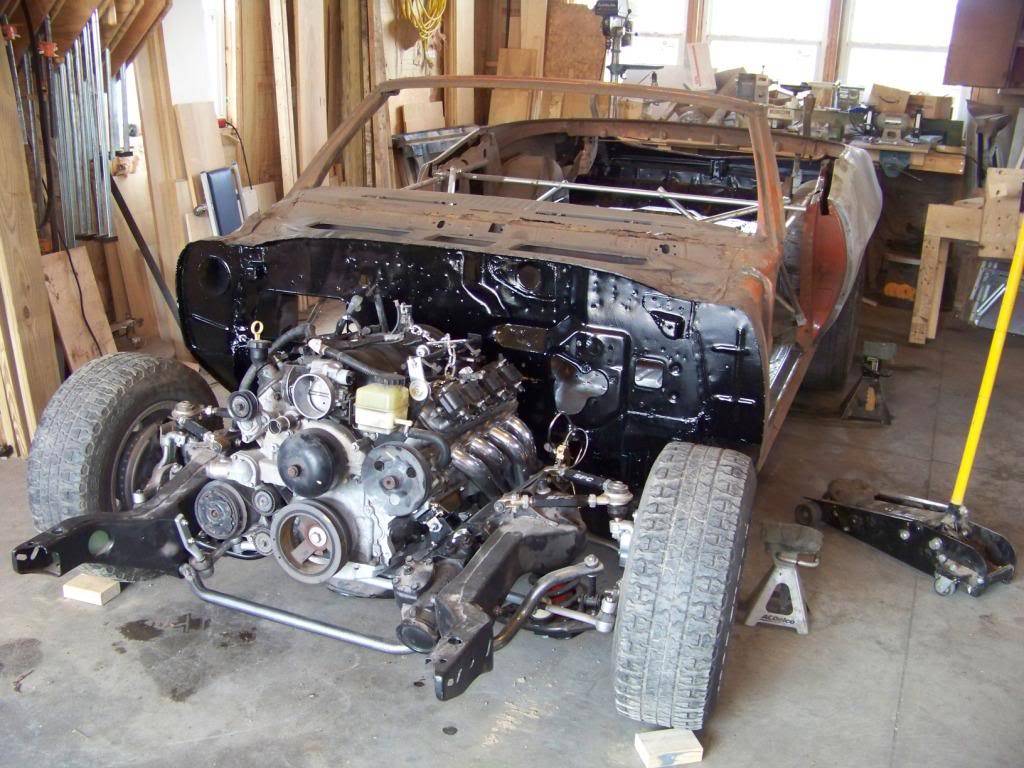
When I removed the body from the frame most of the cage nuts were rusted to the point where they either broke or I had to cut through the bolt. I don't particular care for this GM design where the nuts were hidden in body cavities the way they were, if the body were ever to be removed again I wanted the process to be easier. I also wanted to use stainless fasteners as much as possible and cage nuts don't come in stainless. Here is what I came up with.
In most locations I drilled 1 1/2" holes through the sheet metal floor directly above the bolt locations. I did this by first drilling a small pilot hole through the sheet metal floor from the bottom through the larger body hole in the floor brace while the body was rotated on the rolltisserie. I then drilled the 1 1/2" hole from the top through the floor using a bi-metal hole saw. I bought 7/16" stainless bolts of varying lengths along with stainless nylon lock nuts and large stainless fender washers. I also used new rubber body mount bushings I bought from OPGI, and used the cone washers that came with the kit but not the bolts.
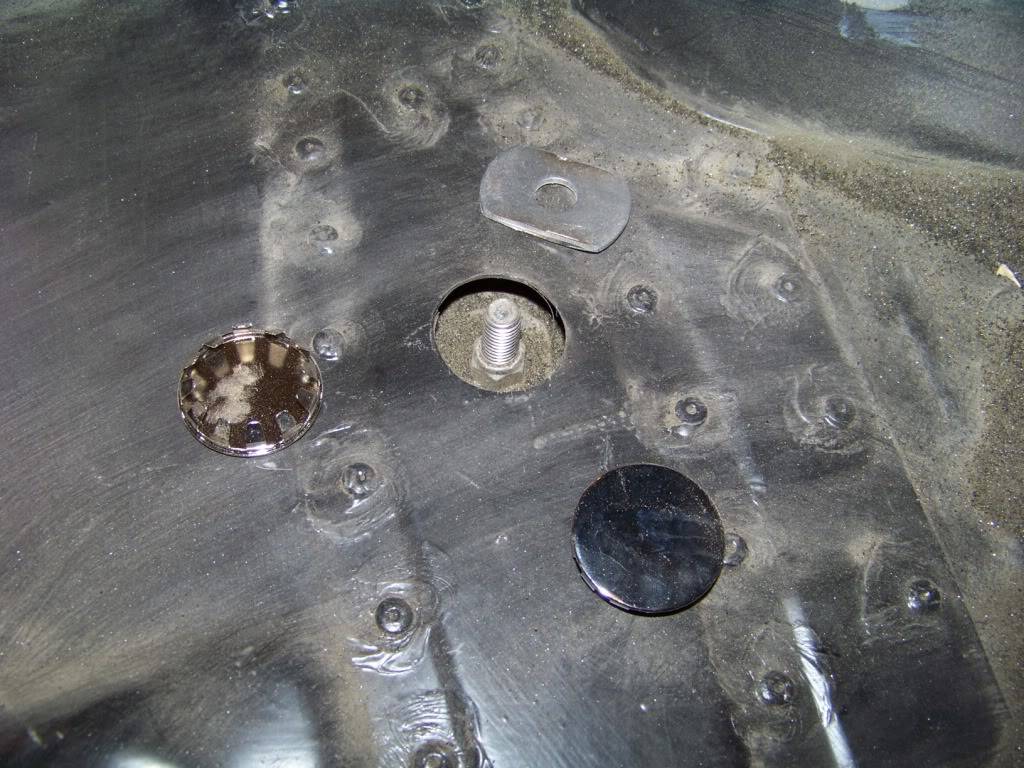
I had to trim the upper washer as shown so it would fit through the 1 1/2" hole in the floor. I was able to reach all of the bolts and nuts to tighten them by myself except the ones under the trunk hinges, those need two people to do. The hole in the floor will be covered up with the 1 1/2" diameter chrome cap, which is a standard item in the blue hardware drawers at Lowes. I will just run the Dynamat over these covers.
The most rear mounts were a little different situation due to where they were located. I cut a square hole in the area in the trunk to access the cavity to install the washer and nut. I will make a overlapping cover panel which will be painted and installed with stainless screws and sealant. Cutting these holes also allowed access to spray the cavity with internal frame coating.
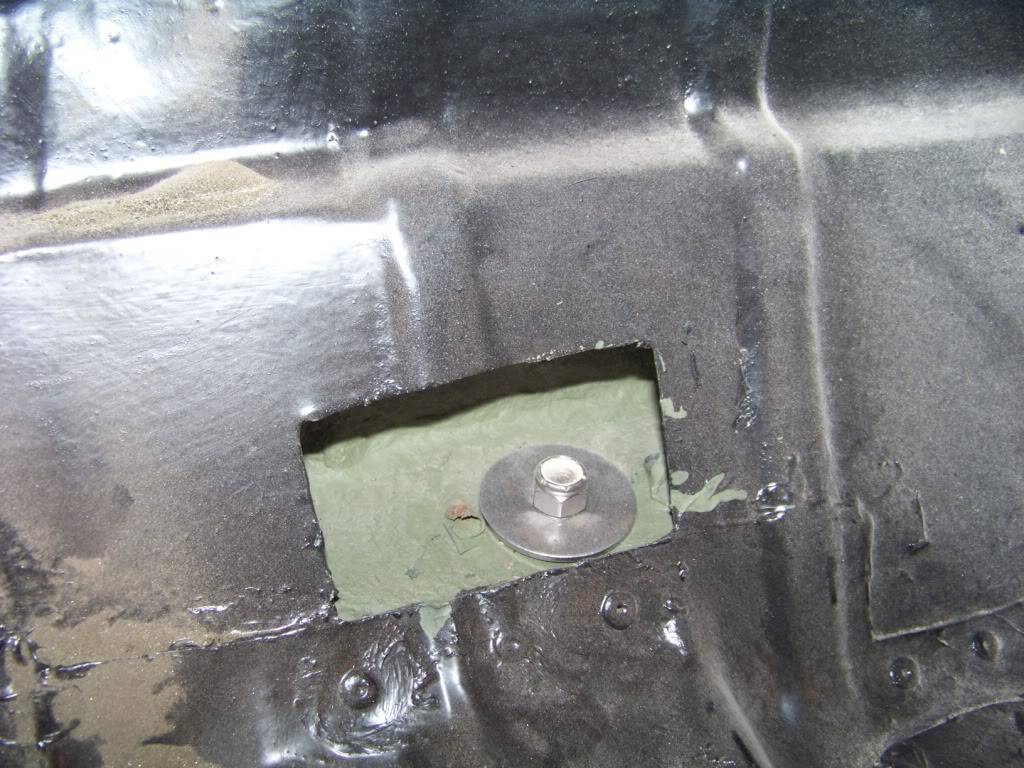
10-23-2012 #24 Registered User
Registered User
- Join Date
- Nov 2011
- Location
- Springfield, OH
- Posts
- 58
Once the body was back on the frame I was eager to get the engine started as most of you would. So that meant I needed to get a lot of things installed in the engine bay.
I noticed on the new GTO a lot of components were mounted on the inner fenders. I wanted to move things over as simply as possible so I figured I would reinstall these components in similar locations on the Lemans. I didn't want to rework the harness and possibly create a lot of headaches so that's why I was compelled to use the existing component locations as much as possible. I had previously blasted, primed and painted the inner fenders in preparation for this time so I went ahead and installed them. I also installed the radiator core support and passenger fender to help support it. I am going for a factory look here, as if GM would have built a 71 Lemans with 2004 technology.
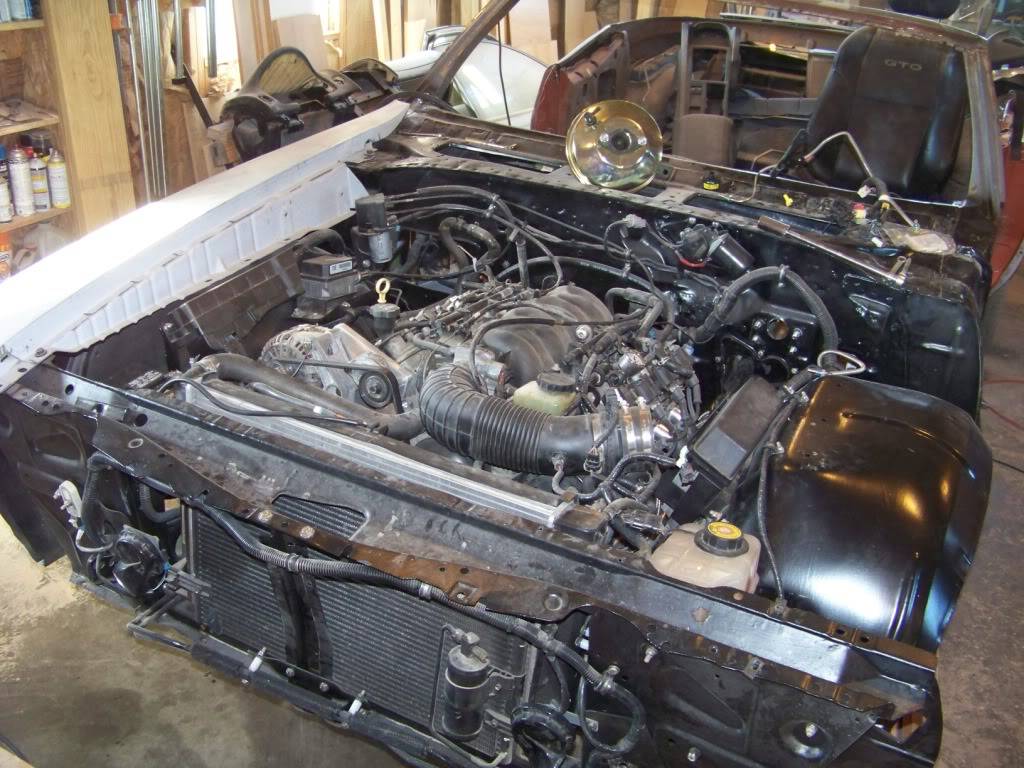
On the new GTO the underhood fuse panel and cruise/throttle cable components are mounted on the passenger inner fender. These pictures shows how I mounted these. I made brackets as required and attached everything through existing or new holes in the inner fender with stainless bolts. When placing components I kept in mind that the associated connectors on the wiring harness had to reach the components so I laid the wiring harness over the engine bay as I did this process.
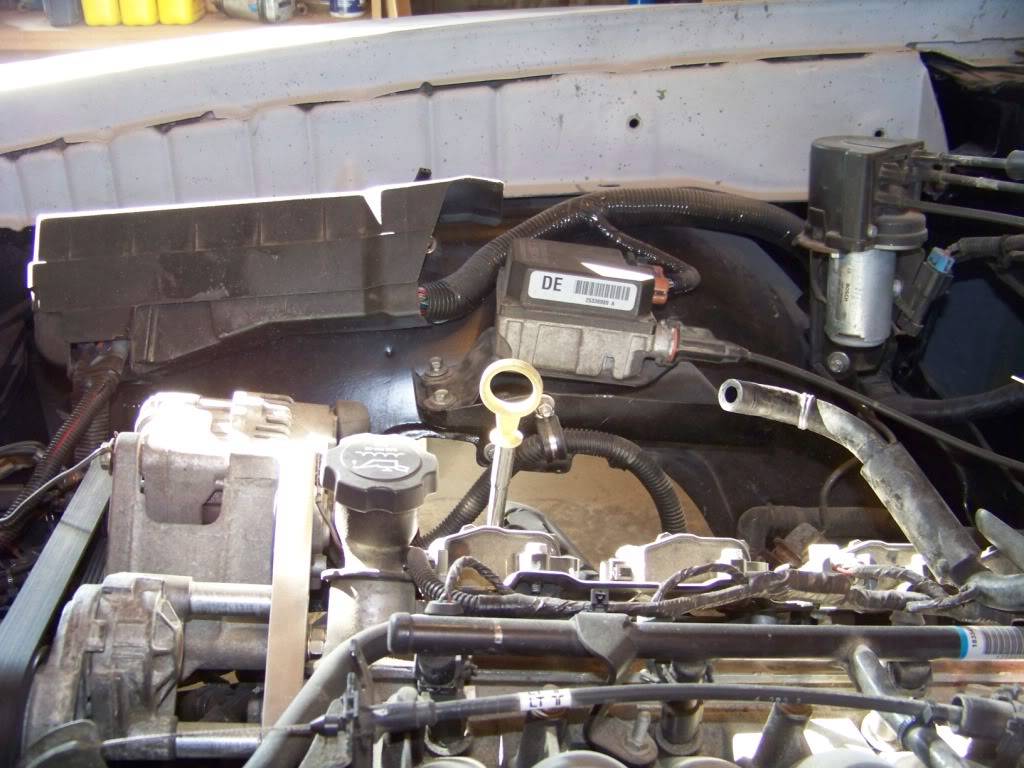
This picture shows the mounting of the underhood fuse panel.
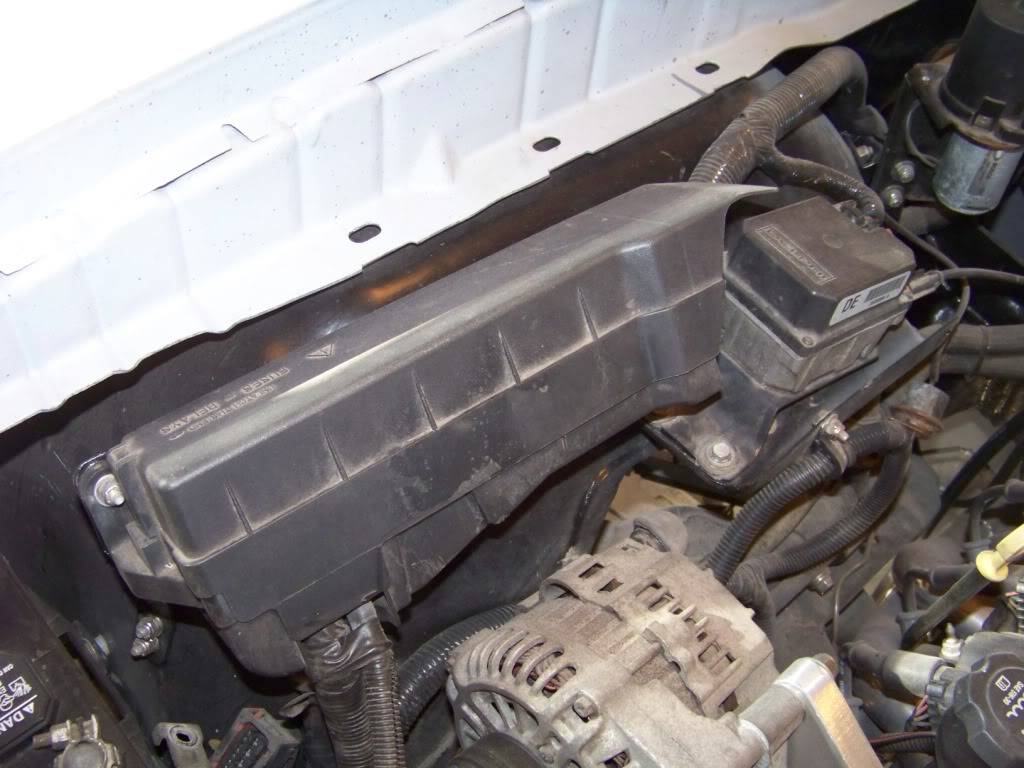
The fuse panel attaches directly to the inner fender on the back side, the forward side needed a bracket I made to support it:
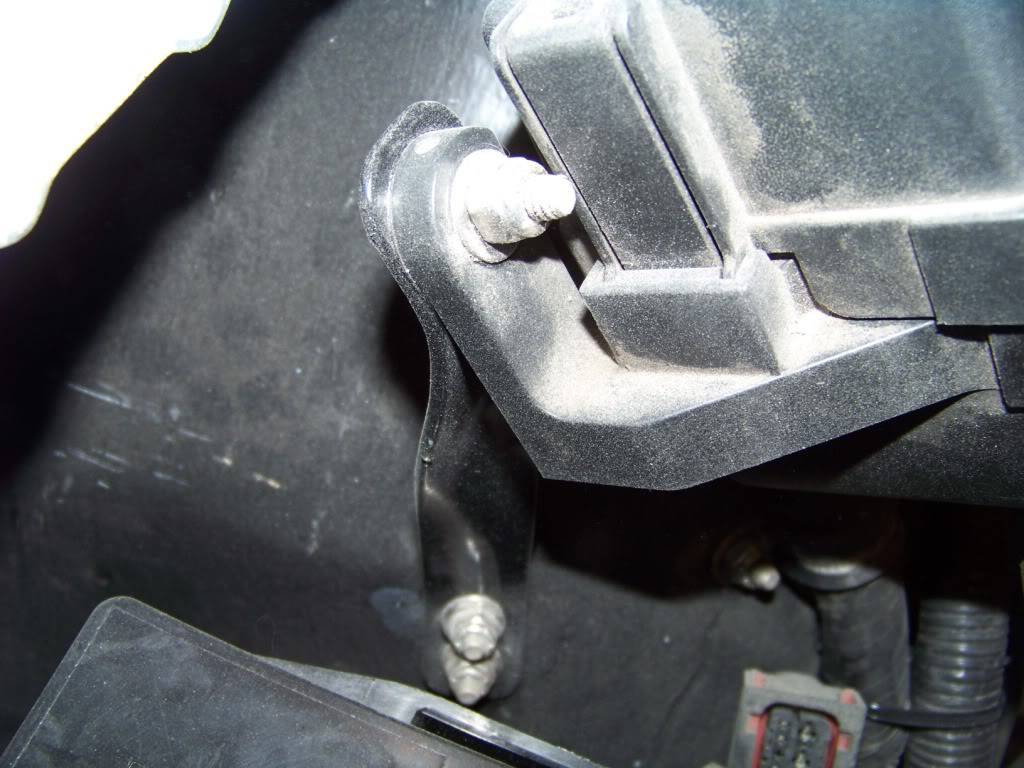
This picture shows the mounting of the cruise and throttle cable components.
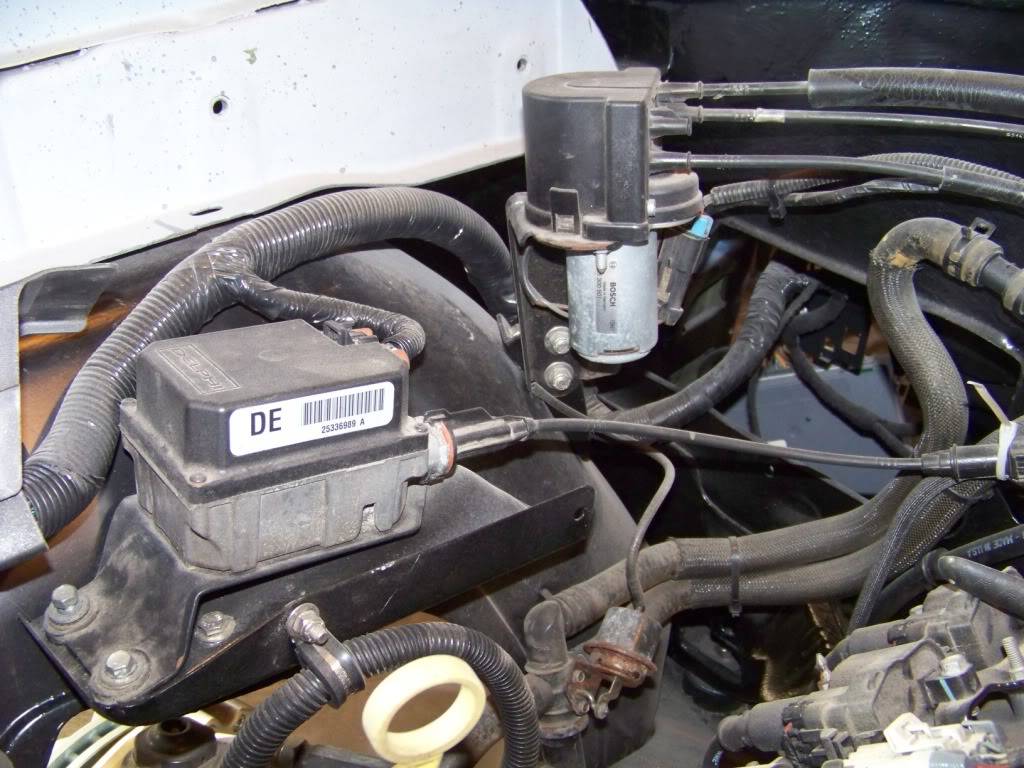
I am not sure exactly what these components are, I assume the forward box shaped item is the cruise servo, the rear cylindrical thing is where all the cruise and throttle cables come together. For the cruise servo I cut the supporting bracket from the GTO donor and mounted it with a supporting bracket underneath that I made.
For the cable component I made a bracket from some angle to support it on the inner fender, this is a view looking down, forward is to the right:
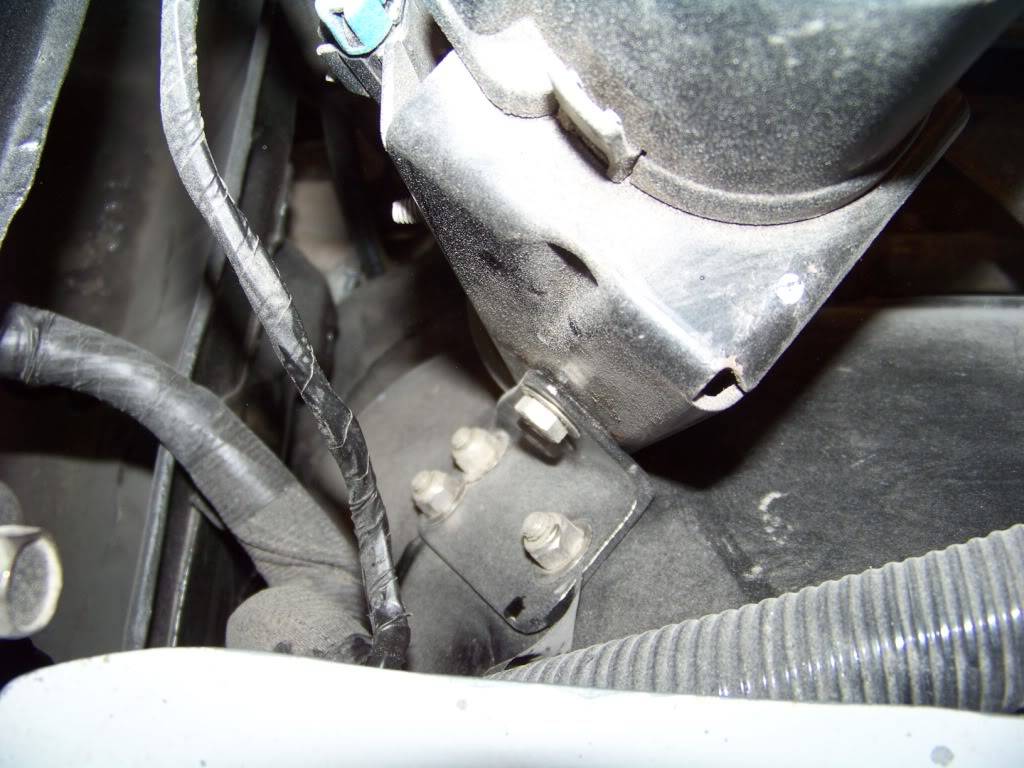
On the new GTO the battery is located on the passenger side just behind the headlight. I was at a car show a few months ago and noticed on Pontiac A-bodies the battery is on the driverís side and on Chevelles the battery is on the passenger side. To keep things the same as the new GTO I mounted the battery on the Chevelle or passenger side. Since my GTO donor didnít come with a battery I got a new one from Autozone. I got the correct battery for the new GTO, it fits in the a-body location just fine.
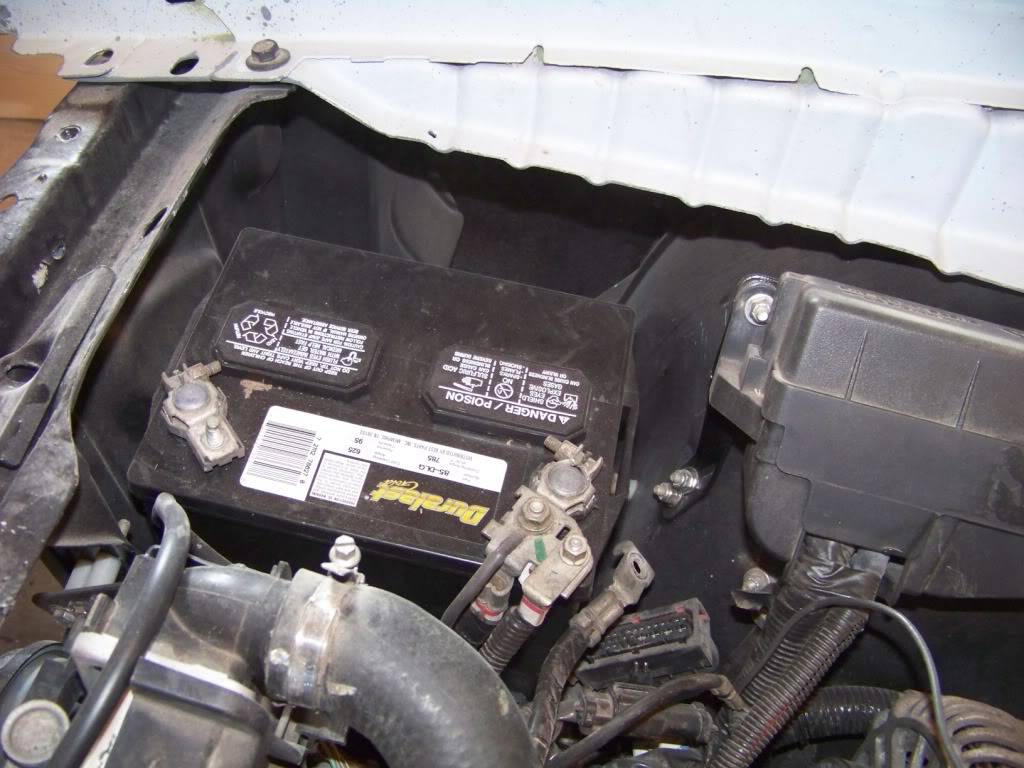
On the new GTO the ECM is mounted on the lower driverís inner fender just above the frame rail. Again, I picked a similar location although I moved it up to get it away from the header. The ECM is mounted in a plastic holder with a cover. I just used the holes in the holder to locate new holes in the inner fender.
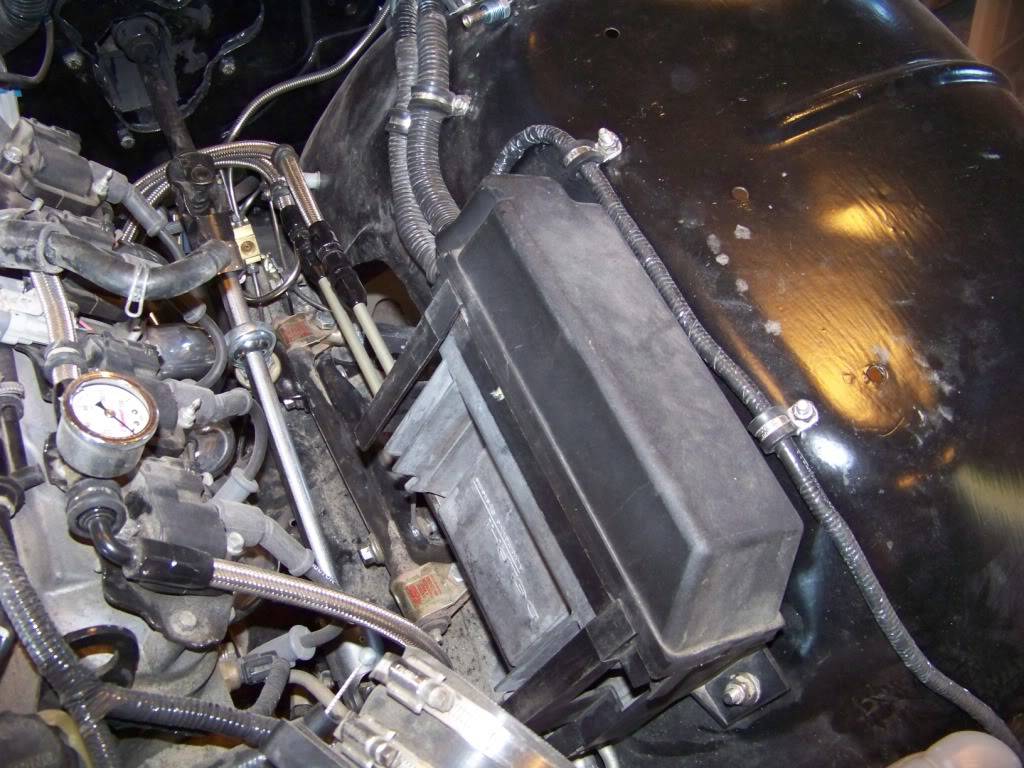
10-25-2012 #25 Registered User
Registered User
- Join Date
- Nov 2011
- Location
- Springfield, OH
- Posts
- 58
Alternator Relocation
As I mentioned in a previous post I decided to relocate the alternator after I discovered it would interfere with the steering gearbox. I looked into the different kits on the market to accomplish the task but didnít want to spend the money. These kits start at about $150 and go into several hundreds for the fancy kits with polished parts and such. For this project I am more interested in function than form so I set about making my own mount.
I decided to relocate the alternator up high on the passenger side. This brings it up closer to the battery and underhood fuse panel. I think it would have been tougher to put it high on the driverís side with the existing power steering pump.
The alternator was originally mounted on the front of the block down low on the driverís side. It appeared to me that the front of the driverís side head was on the same plane as the front of the block, and I researched and found out that the passenger side head is offset to the rear about 0.75 inch. So I decided to base my bracket on a 0.75 think aluminum plate figuring that would put the alternator roughly in the same plane again. I went through several designs using ĺĒ particle board until I had a design I was happy with. I actually spent more time fussing with the tensioner relocation trying to get the proper leverage to tension the belt. This bracket relocates both items.
Below is a drawing with dimensions of my bracket. I made it from a 8 inch by 8 inch by 0.75 inch aluminum plate that I bought from McMaster for about $39 (part number 9246K51). At the time I didnít have access to a machine shop so I cut this plate with a reciprocating saw and finished it with belt and spindle sanders. Crude, but I got it done.
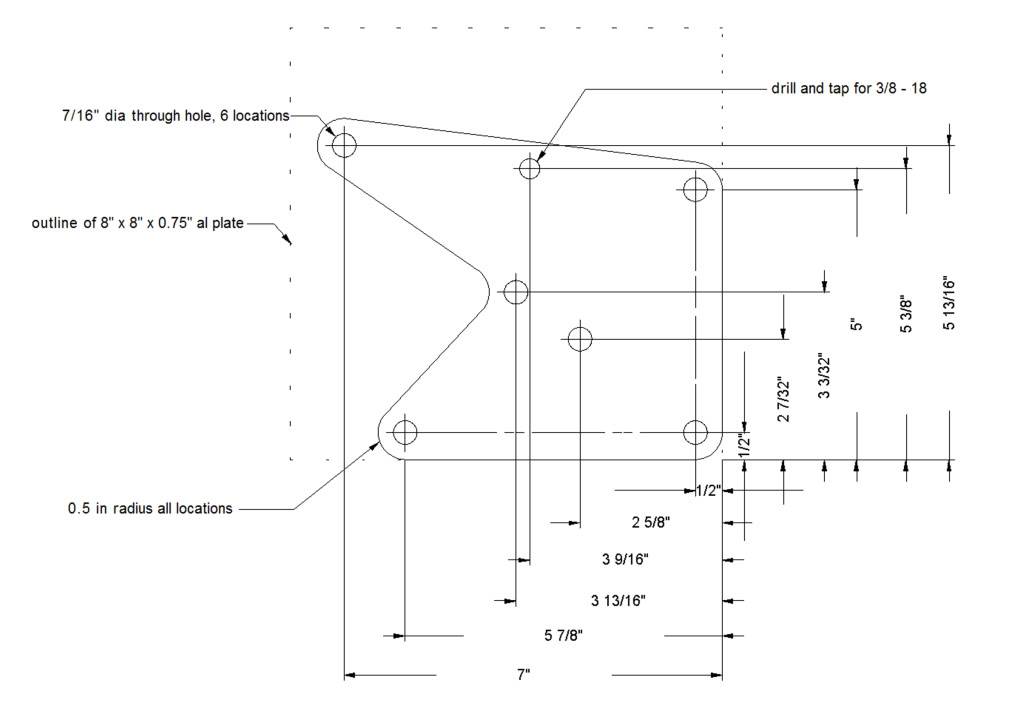
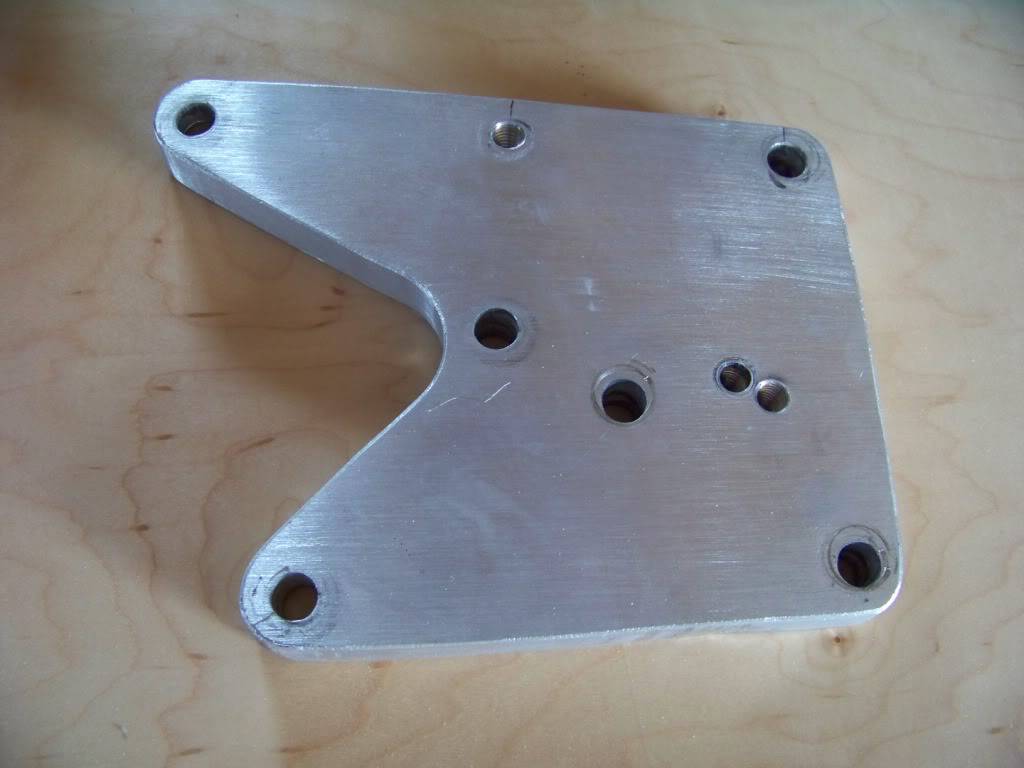
Disregard the two holes right next to each other, they were from an earlier unsuccessful attempt to relocate the tensioner bracket.
The picture below shows where I mounted the bracket. I am using the three outer holes on the front of the passenger head. The fourth most inner hole is not used. In this picture you can also see the two holes just below on the water pump that used to support the tensioner bracket.
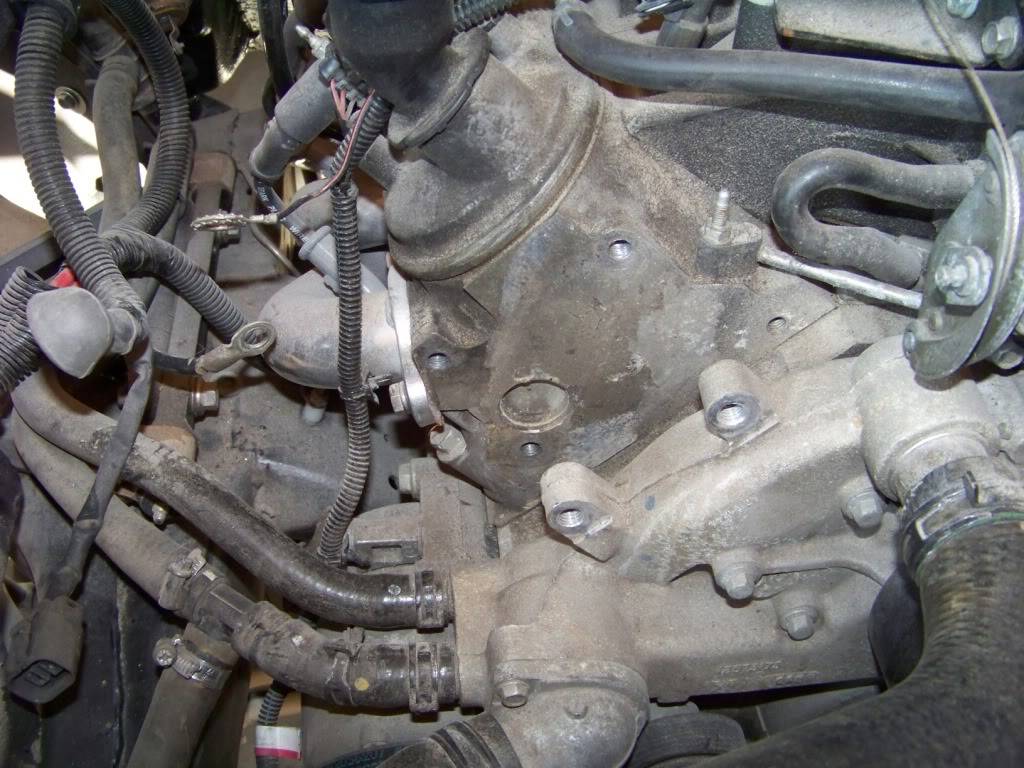
The bracket is mounted to the front of the passenger side head with M10-1.5 x 40 bolts as shown below. The holes in the head are already tapped to that thread size.
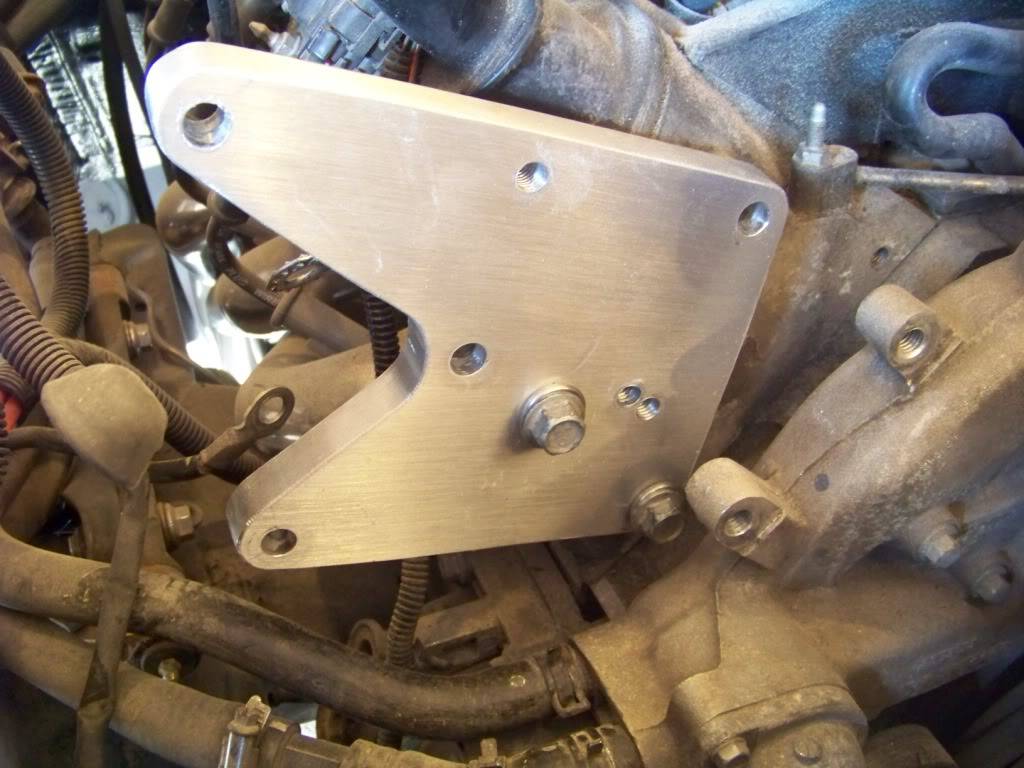
The alternator is mounted to the bracket with two 3/8 x 5 1/2 in. bolts and one 3/8 x 4 1/2 bolt, I used grade 8 bolts.
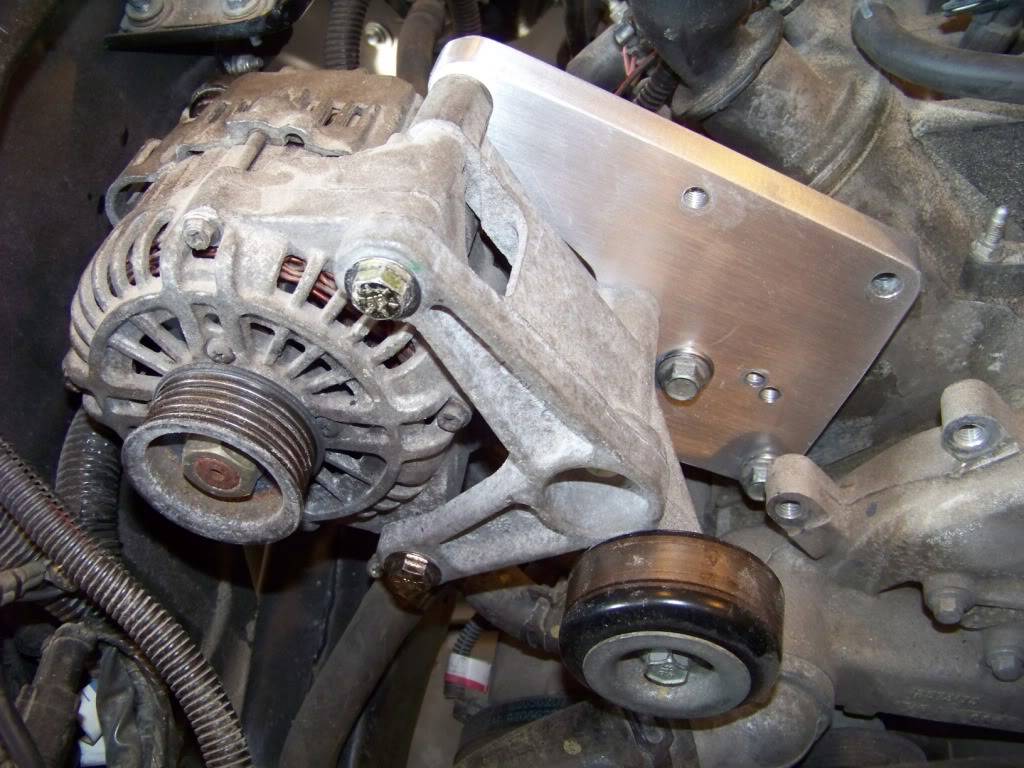
The tensioner is mounted with one M10-1.5 x 130 bolt in the inner hole, this bolt goes through the hole on the bracket and into the existing hole in the head. The outer bolt is 3/8 x 4 and threads into the bracket. To keep the tensioner aligned with the other pulleys it is installed with spacers between the alternator bracket and the tensioner bracket. These spacers, made from 1/2" pipe or heavy conduit, are 1.70 inches long.
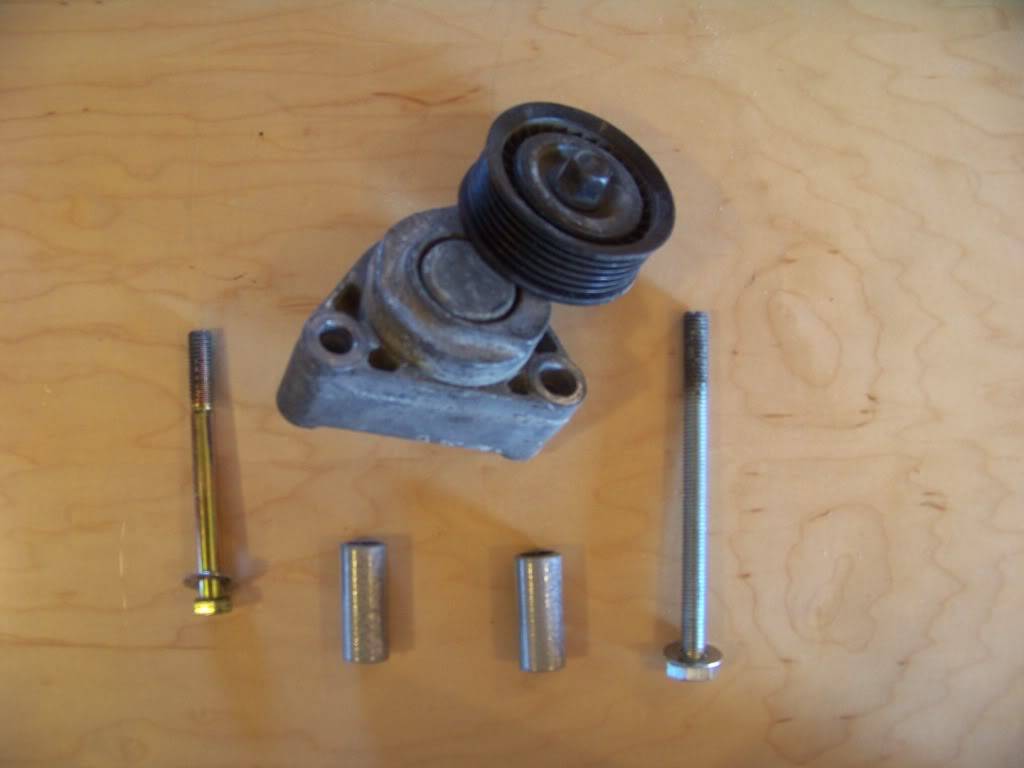
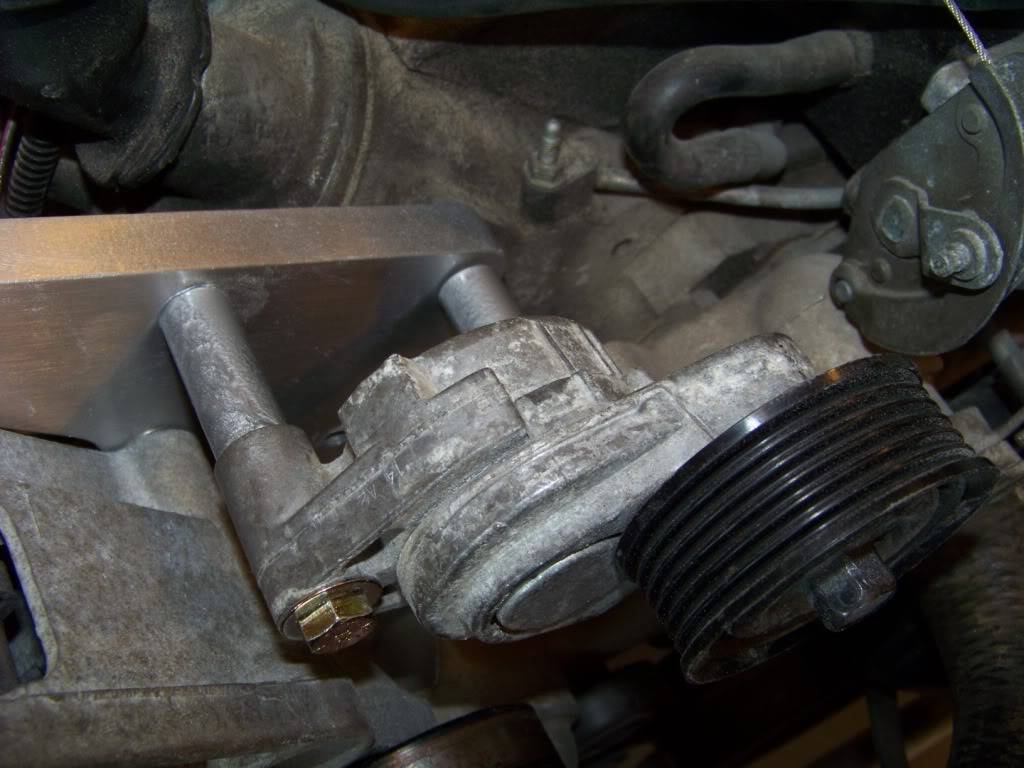
I put a straightedge across some of the pulleys to make sure they were in the same plane, I did put one washer between the alternator and bracket at each of the three bolt locations to get the pulleys in the same plane.
For the belt I tried measuring with a string and then a metal tape measure wrapped around all of the pulleys but that only got me a starting point for belt length. From there it was a trial and error process of getting belts from the auto parts store and trying different ones until one worked well. For this particular installation that ended up being a Gates K060815 belt (six ribs, 81.5 inches long). This belt fits pretty snug, the tensioner is at the higher end of its scale.
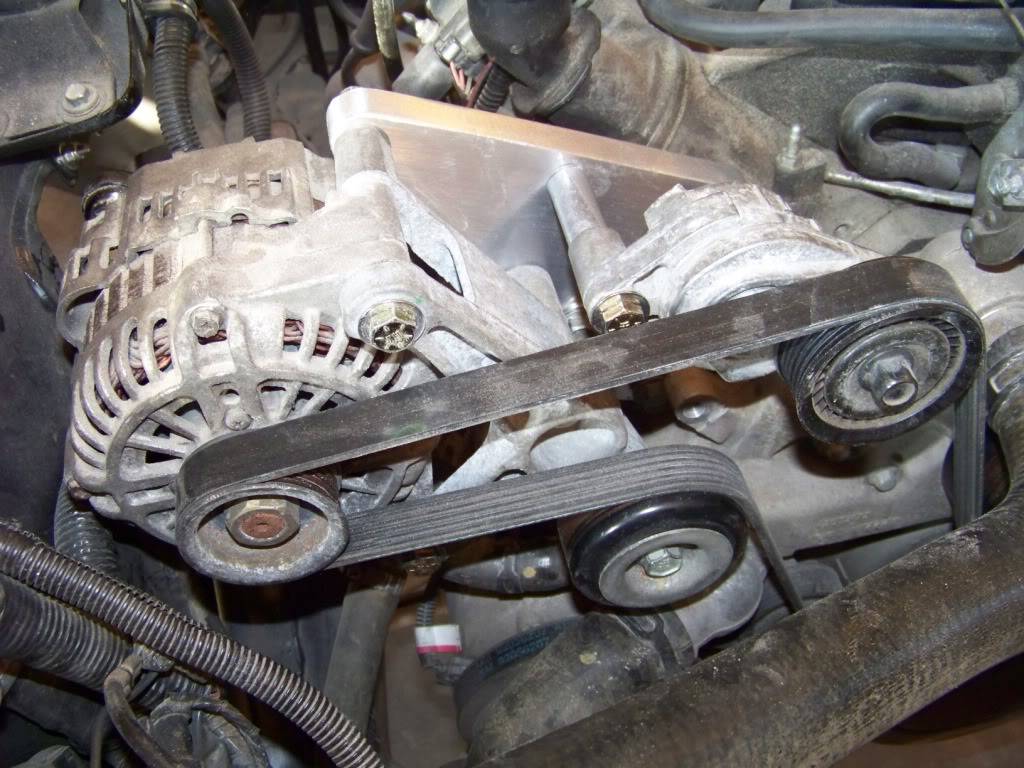
The bracket seems very sturdy and I have run the engine several times without issue, although not at full throttle yet.
10-26-2012 #26 Registered User
Registered User
- Join Date
- Nov 2011
- Location
- Lowell MI
- Posts
- 50
That's a nice bracket!
10-28-2012 #27Enjoying the build. Hope my 70 doesn't have any hiddend problem. Yep that's a 70 front bumper. 6th digit of the vin is the last digit of the year. 0 for 70.
My understanding is that bumper was a major pain to pres and didn't make a full model year. Only on 70 did it have lemans on the rear 1/4 in front of the rear bumper. It had 3 horizontal gills behind the front wheel opening. The chin changed with the bumper and I think the 70 will not work with any other year front fenders. The 70 shared hood with 69..
My 70 was dec 69 delivery and the jack instruction stickers are 69.
Curious if its a 70 nose or a 70 car.Eric
"He has all the virtues I dislike and none of the vices I admire." Winston Churchill
70 LeMans Sport Convertible. Mildly built 1978 W72 400 aka T/A 6.6, Eddlebrock RPM intake, Demon 750 Factory Munci 3 Speed with Hurst, Factory Safety Track (Posi).
10-29-2012 #28 Registered User
Registered User
- Join Date
- Nov 2011
- Location
- Springfield, OH
- Posts
- 58
Yes, the front end on the car did have a 70 Lemans bumper when I bought it. It is a 71 according to the title and the VIN. I was given a bit of a hodge podge of front parts for the car when I bought it (including the 71 Lemans bumper and a 68-70 GTO hood) from different years but unfortunately I don't have everything for one particular year. I later bought the front sheet metal (except for the hood) from a 1972 GTO but it's not in great shape and I don't know if I will use it. I am leaning towards doing a 1970 GTO front, trying to find a bumper now.
10-29-2012 #29Well don't toss that 70 LeMans bumper. HARD to find, more so then the GTO. If its straight I might be interested in it and the hood if I can figure out how to get it down to GA cheap. Also looking for the front side orange reflectors for 70 Lemans if you happen to have a good set. I didnt manage to get NOS front signal lenses to replace my broken ones.
Hate to say it but I don't think the 70 LeMans fenders will work with the 70 GTO endura nose. Good lord has the price gone up at Goodmark on the fenders! :(Eric
"He has all the virtues I dislike and none of the vices I admire." Winston Churchill
70 LeMans Sport Convertible. Mildly built 1978 W72 400 aka T/A 6.6, Eddlebrock RPM intake, Demon 750 Factory Munci 3 Speed with Hurst, Factory Safety Track (Posi).
11-03-2012 #30 Registered User
Registered User
- Join Date
- Nov 2011
- Location
- Springfield, OH
- Posts
- 58
No, I have no intention of tossing any bumpers. I was given both 70 and 71 Lemans chrome bumpers, both are straight with just very minor scratches, but they need to be re-chromed. I do want to sell them at some time, I don't think I will use them, I like the GTO look better. I also have the bumper brackets, grilles, and header panel that goes between the bumper and hood for the 70 Lemans.
The other day I bought a 1970 GTO Endura bumper for $200, unfortunately it didn't come with the bumper brackets, grilles or headlight parts; I will have to start looking for those or find another bumper that has them. As I said, I am leaning towards doing the 1970 GTO front so will probably also use the 68-70 GTO hood I have.
You are right, the 1970 Lemans and GTO front fenders are different, but just in the lower front corner. I have seen pictures on the internet where the Lemans fenders are converted into GTO fenders by welding in some metal to fill in the pocket where the Lemans bumper wraps around into the fender, I even ran across a company that sells patch panels for that very purpose. Some really nice 1970 Lemans fenders came with the car so I am thinking of doing this.
I don't have the front side reflectors for the 1970 Lemans, sorry.
11-03-2012 #31 Registered User
Registered User
- Join Date
- Nov 2011
- Location
- Springfield, OH
- Posts
- 58
Power Steering
This was one of the easier parts of the swap to do. I discovered in tearing down the GTO donor that it had a power steering cooler. I thought why not, if they thought it important to have one I will move that over too. This picture shows the mounting of the cooler in front of the core support. As you can see it was fairly simple to mount, I just made a flat strap to support the cooler at it's existing bolt locations and to the core support upright.
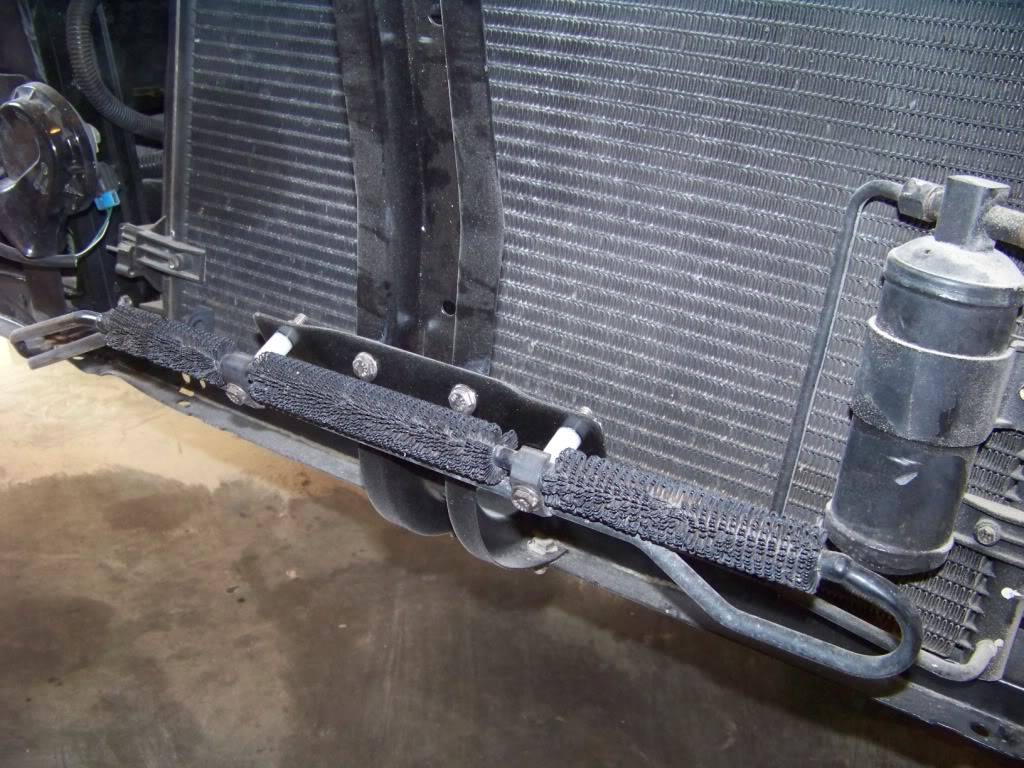
As mentioned in a previous post I swapped the old steering box with one from a 96 Jeep Grand Cherokee which is a direct bolt in and quickens the steering. So I had to connect the power steering lines from this steering box to the power steering pump on the GTO donor. I used two hoses from NAPA, part number 7-1832 for the pressure side and part number 7-1717 for the return side. This isn't a real great picture but this shows these lines installed on the gearbox and power steering pump. These lines need minor tweaking to get them installed.
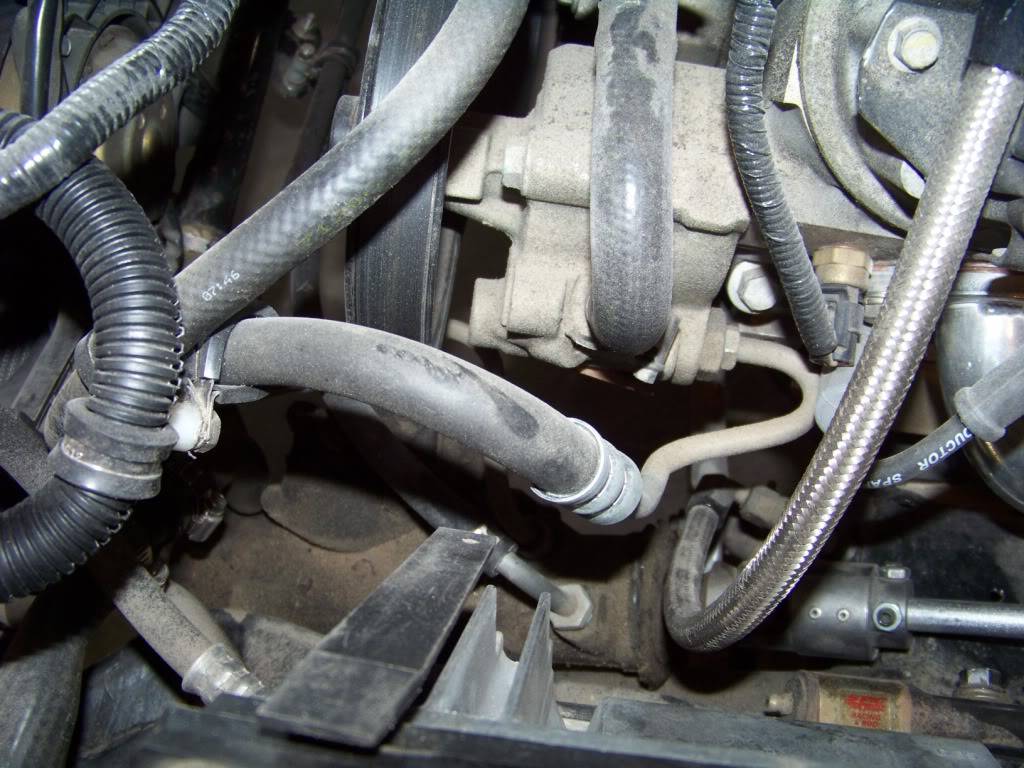
I also bought some power steering return hose to connect to the cooler hardlines which come in around the passenger side of the radiator as shown in the first picture. These run along the rear side of the bottom of the core support, you can just see one line and it's clamp just to the left of the power steering pump pulley in the picture above.
12-01-2012 #32 Registered User
Registered User
- Join Date
- Nov 2011
- Location
- Springfield, OH
- Posts
- 58
An update for my build thread for those of you who may have wondered what's happening . . .
Transmission Cooler Lines
Obviously the transmission cooling lines from the GTO donor werenít going to fit exactly into the Lemans, but I did manage to use most of them. I cut a small section out in each line from where they went around the driverís side header and joined the lines with some AN fittings and braided hose. The fittings I used were -6 AN 3/8 hard tube fitting adapters (part number SUM-2200077B at Summit, four required) for the cut ends of the tubes and -6 AN straight hose ends (part number SUM-220690B, again four required) and two appropriate lengths of -6 AN hose.
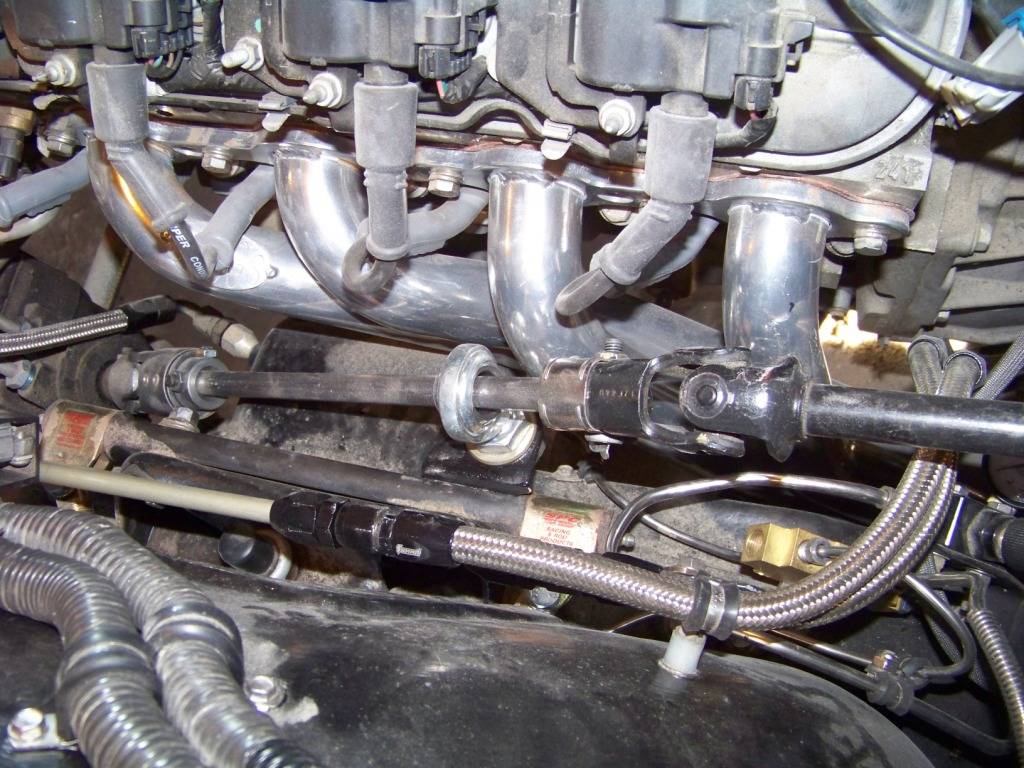
I thought about doing the whole thing in AN lines, but it would have been a lot more expensive due to the special adapter fittings required at the radiator and transmission.
This picture also shows the steering linkage which I hope to discuss soon when I get into the interior installation.
12-01-2012 #33 Registered User
Registered User
- Join Date
- Nov 2011
- Location
- Springfield, OH
- Posts
- 58
Cooling System
I was determined to use as many components from the GTO donor as possible and that included the cooling system. The new GTO radiator is slightly taller but several inches narrower than the opening in the Lemanís core support. The GTO radiator apparently just sits in its core support by gravity. So I duplicated how it was mounted into the Lemans. Two posts with rubber bushings protrude from the bottom of the radiator and rest in corresponding holes (upper right below) in the bottom of the new GTOís core support, see picture below.
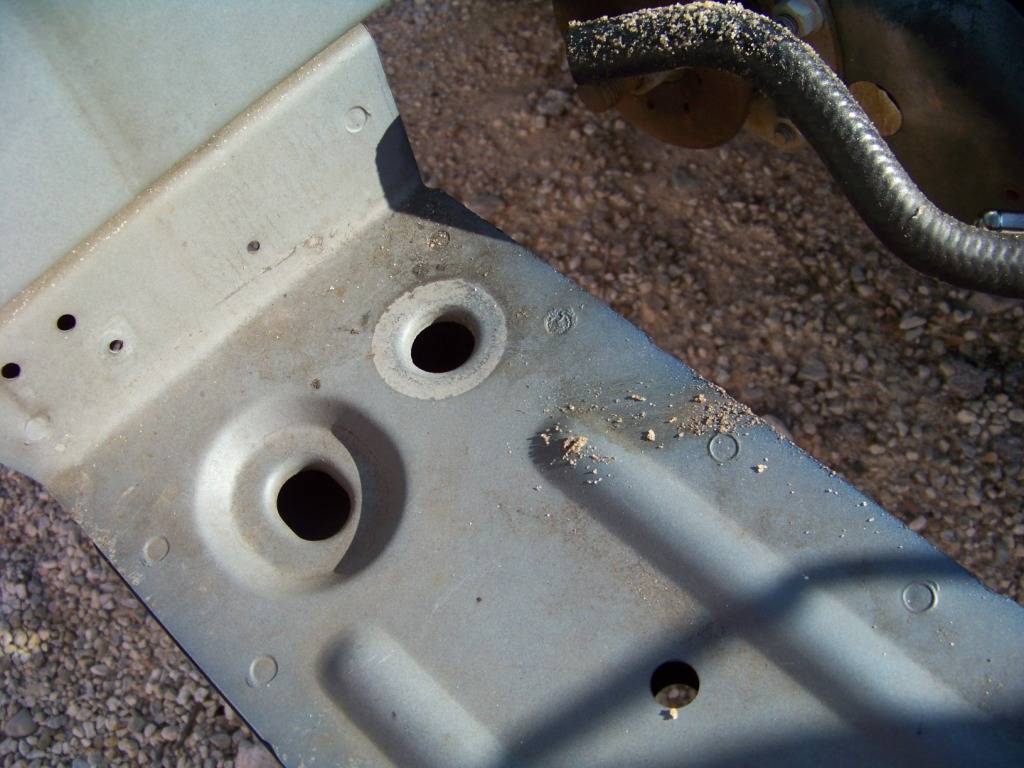
I drilled matching holes in the bottom of the Lemanís core support as shown. In the picture below I am using a screwdriver shaft to hold the radiator up so you can see how it rests into the new holes. Excuse the dust, woodworking and car building don't mix very well.
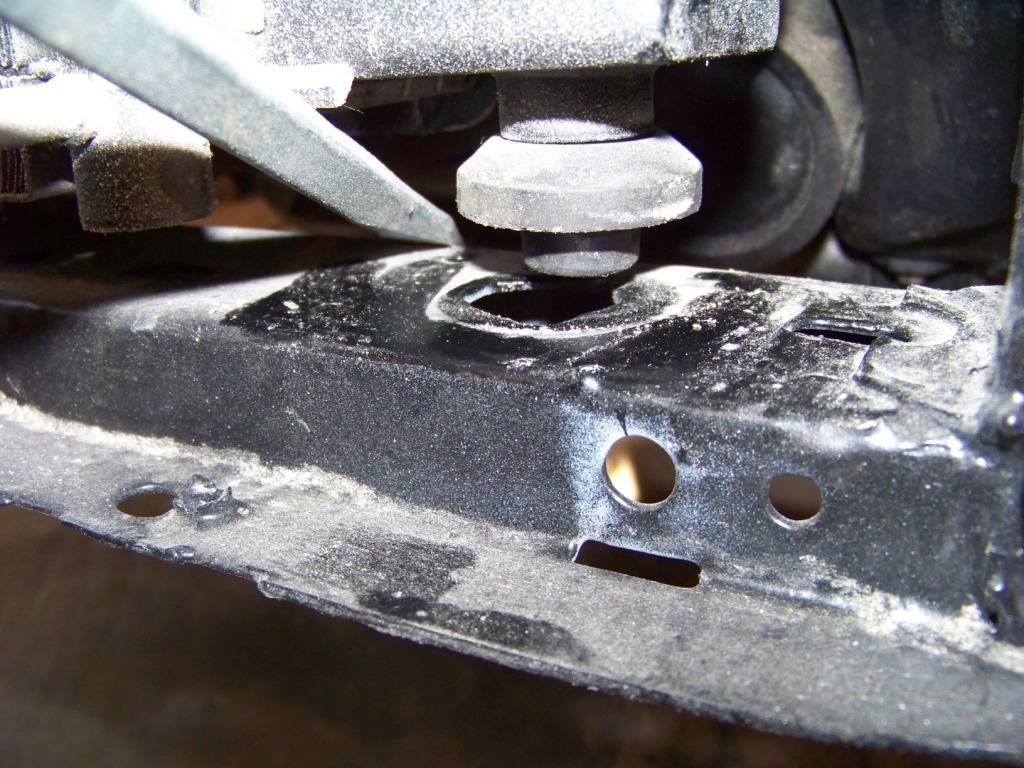
On the outside upper edges of the radiator are rubber doughnut shaped bushings. These slide into u-shaped brackets attached to the core support. These u-shaped brackets were removed from the GTO donor and modified to fit into the Lemans. I welded straps to the u-shaped supports and mounted them on the Lemanís core support with bolts, and nylon spacers.
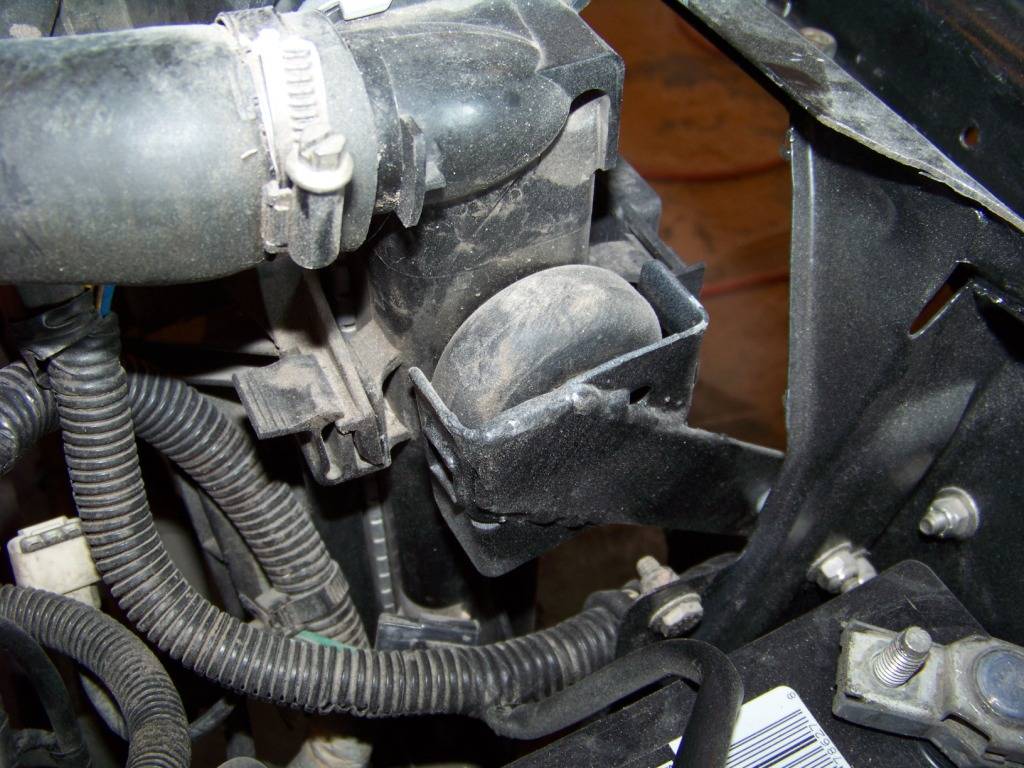
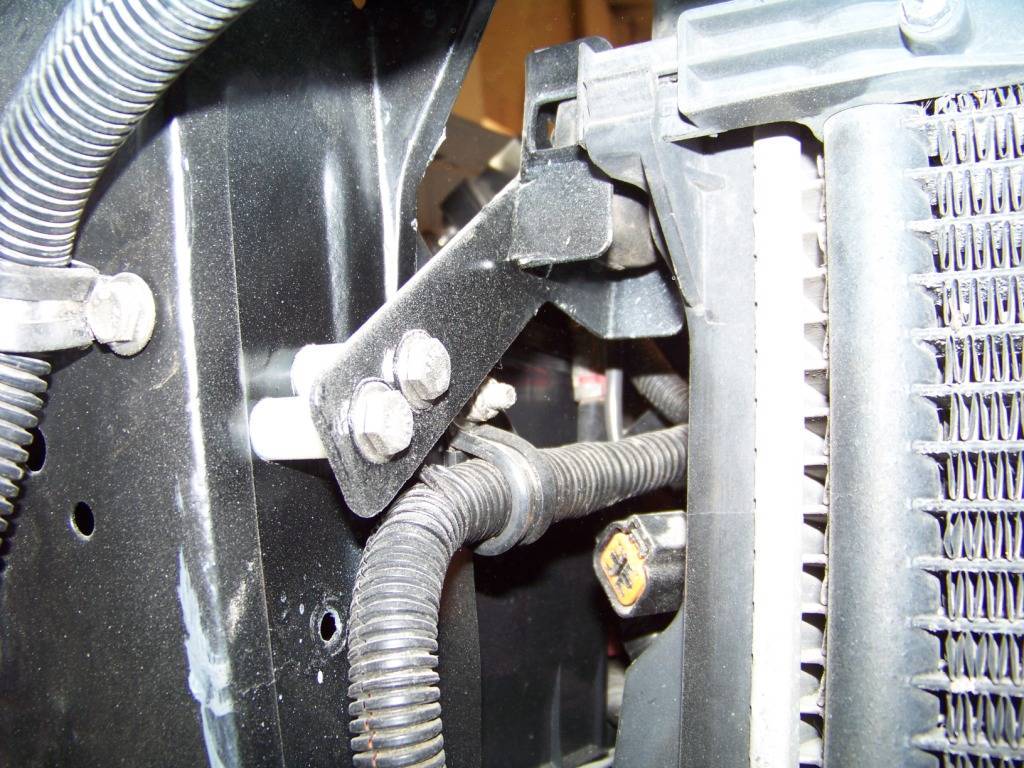
I noted the Lemanís core support leaned forward slightly at the top. I used this to my advantage when I mounted the new GTOís radiator. It sits in the new holes in the bottom of the core support and raises above and behind the core support at the top so the radiator ends up being fairly vertical. I am not sure whatís going to happen at the top of the core support, I removed the upper sheet metal panel when I reworked the core support. The sheet metal will have to be trimmed, and I may come up with a radiator cover at some point.
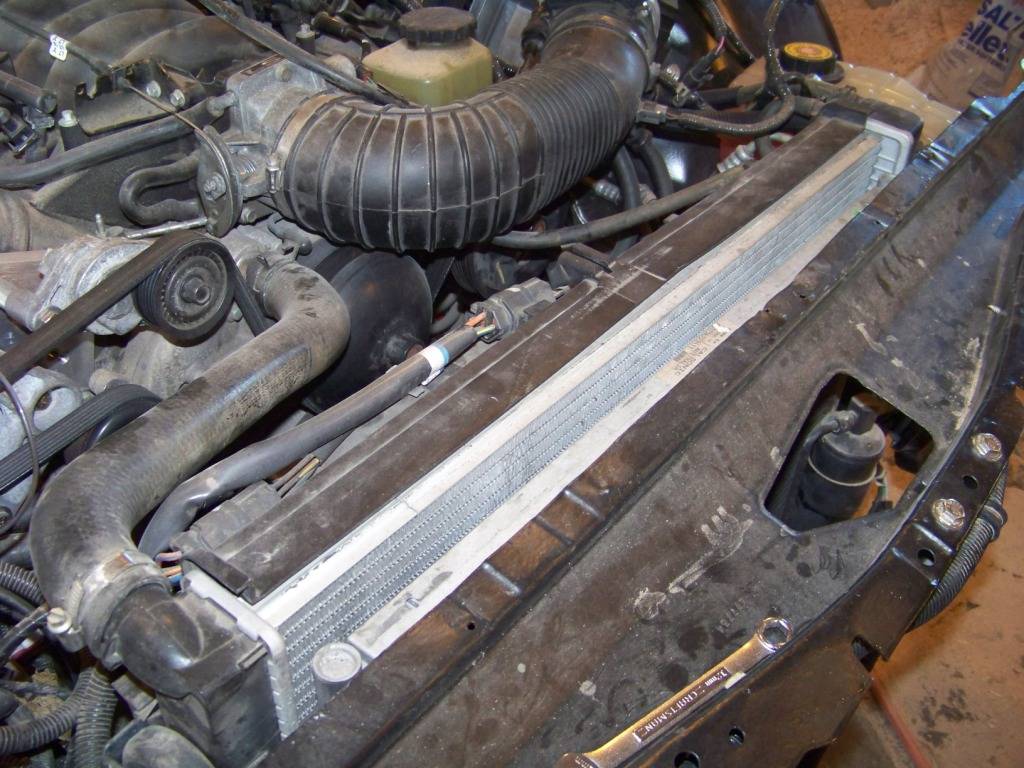
By the way, the AC condenser and electric fans were reinstalled onto the radiator just as they were on the GTO donor. It was easy-peasy because they both attach directly to the radiator so there wasn't any fabrication to do. They both just slide down onto L-shaped brackets on the radiator and snap into place. There is ample room in front and behind the radiator for these components.
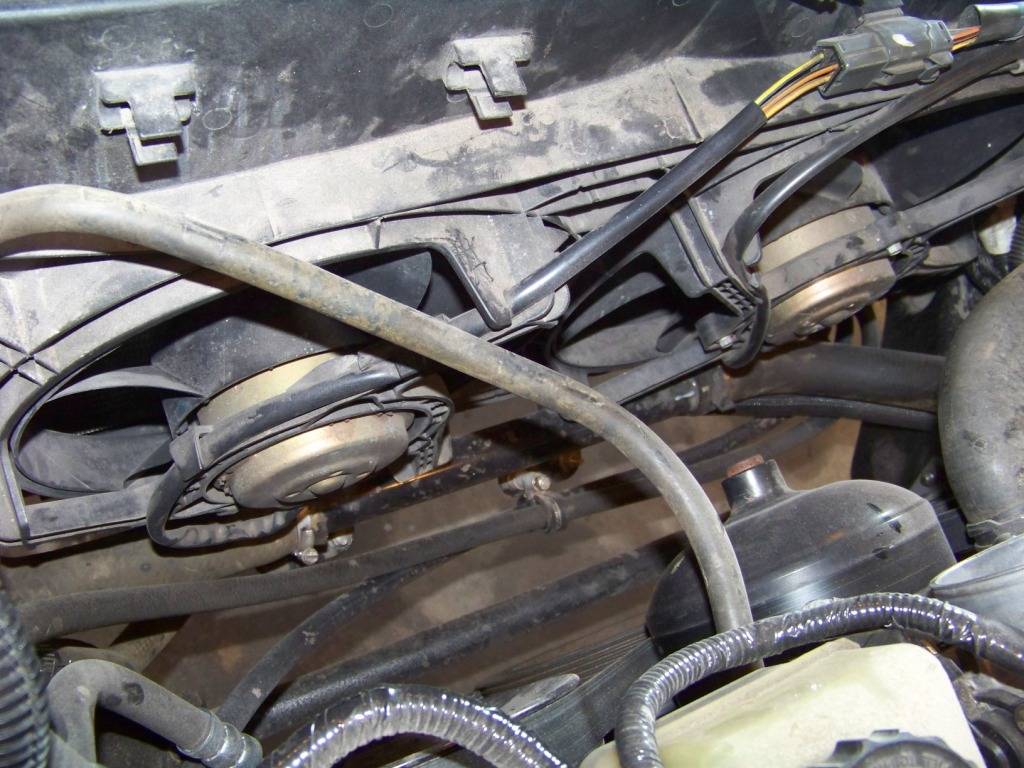
This last picture shows the installation of the coolant recovery tank. My original thought was to get his mounted in a driverís side location in such a way that all the connections would route well to mating components. But I have since discovered that I may have mounted it to low, which is important as I believe the tank helps determine the level of the coolant in the system and mine is therefore may be too low. I will be looking into ways to remedy this issue.
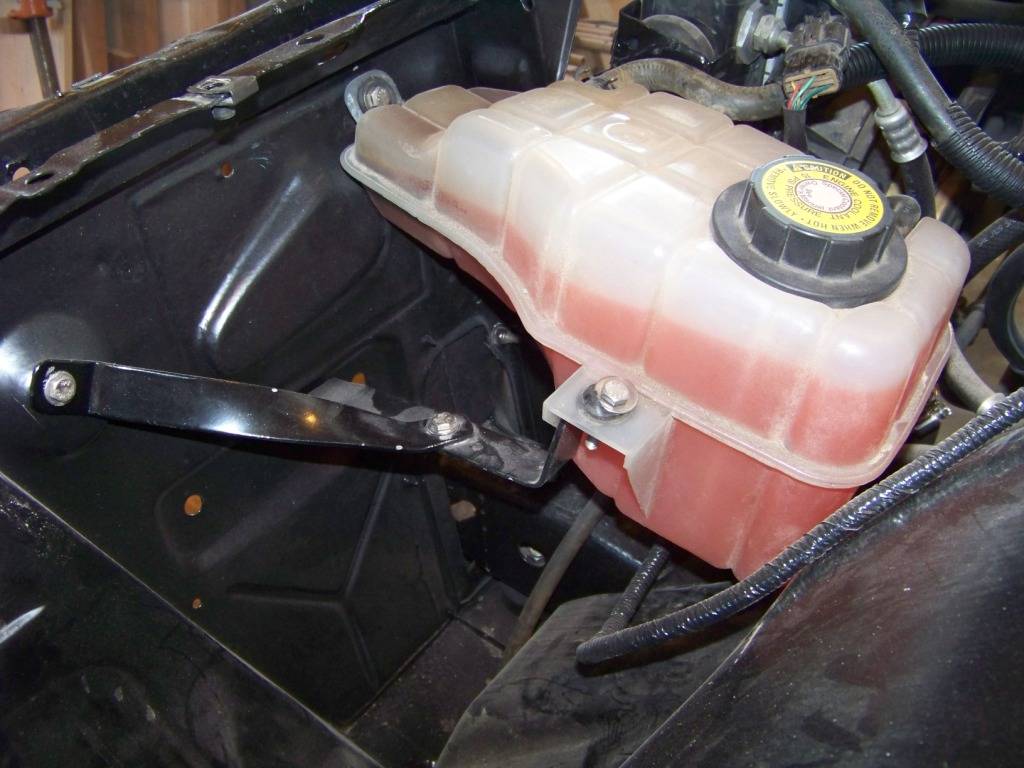
As far as hoses go I was able to use all of the existing radiator and heater hoses from the GTO donor. This will just make things that much easier when I go to the parts store for replacements, I just tell them it's for a 2004 GTO.
02-02-2013 #34 Registered User
Registered User
- Join Date
- Nov 2011
- Location
- Springfield, OH
- Posts
- 58
Cooling System Rework
As I mentioned in my previous post about the cooling system, I discovered that I probably originally installed the coolant recovery tank too low. This post shows how I remedied that.
I tried in vain to figure out a way to raise the tank enough, but I wasnít successful. The only other place I could think of was higher up on the inner fender where the ECM was, but then that means I would have to find another place for that and I was happy with where it was. Then it occurred to me that I could lower the radiator. I ended up doing that and raising the coolant recover tank.
I cut the center part of the lower channel from the core support and made a new lower radiator support from angle iron and tabs welded on as required to support the GTO radiator.
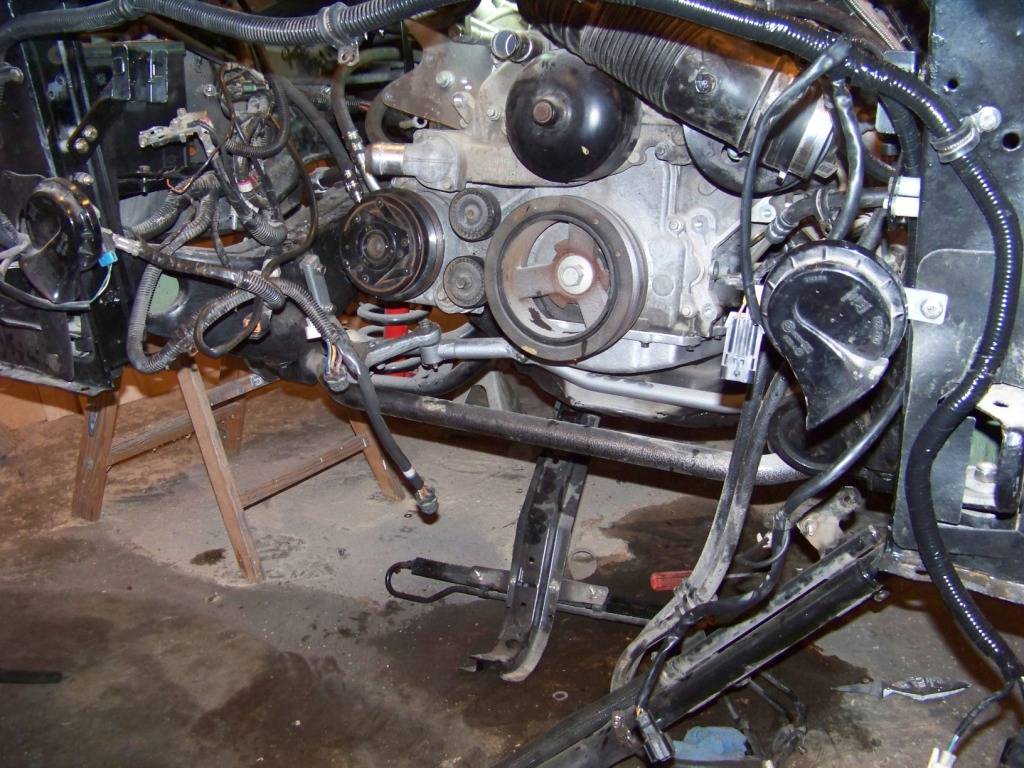
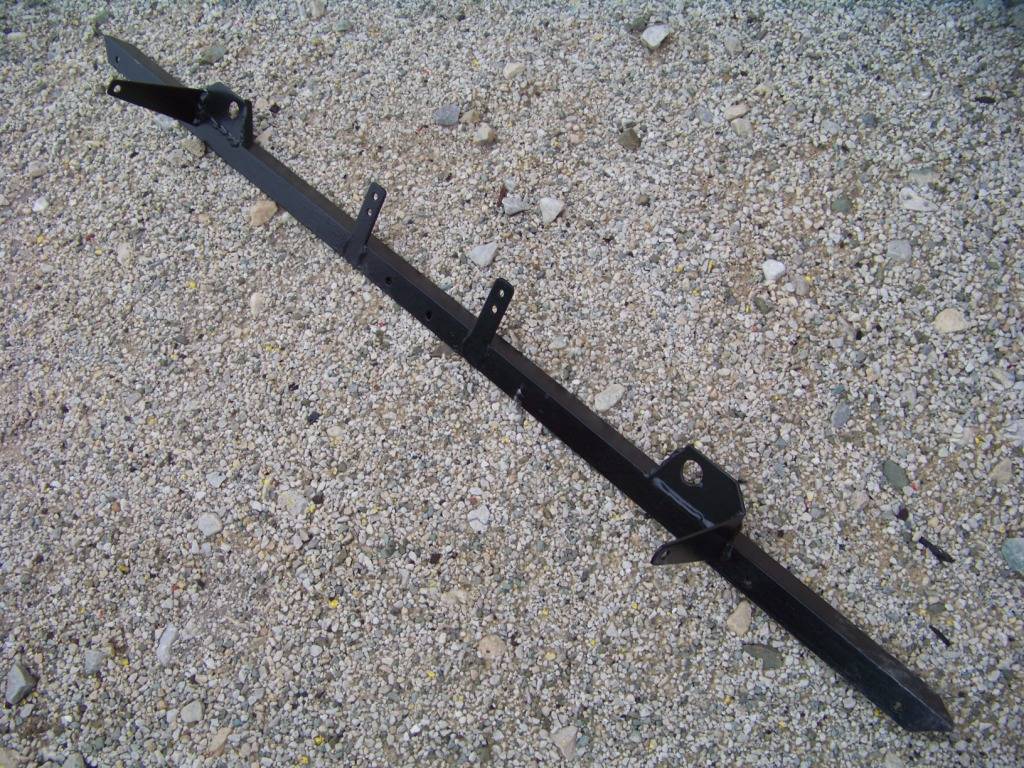
This new support was attached with bolts and spacers to the bottom on the core support as shown. This ended up lowering the radiator about 2 3/8 inches. As a bonus, the radiator no longer sticks up above the top of the core support. The top support brackets for the radiator were also moved down an equal amount. The picture below shows the attachment of the new lower channel on one side, the other side is just the opposite.
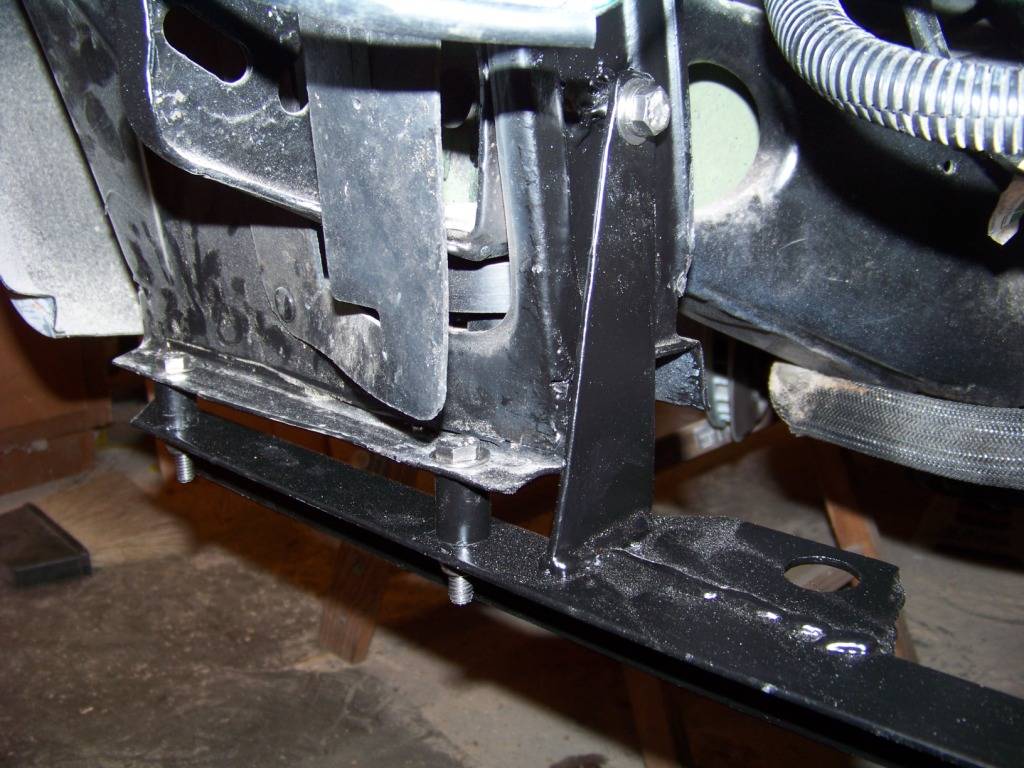
The picture below shows the support and installation for the coolant transfer tubes between the lower part of the radiator and the engine. This assembly was on the GTO so I also moved it over so I could use the GTO's lower hoses.
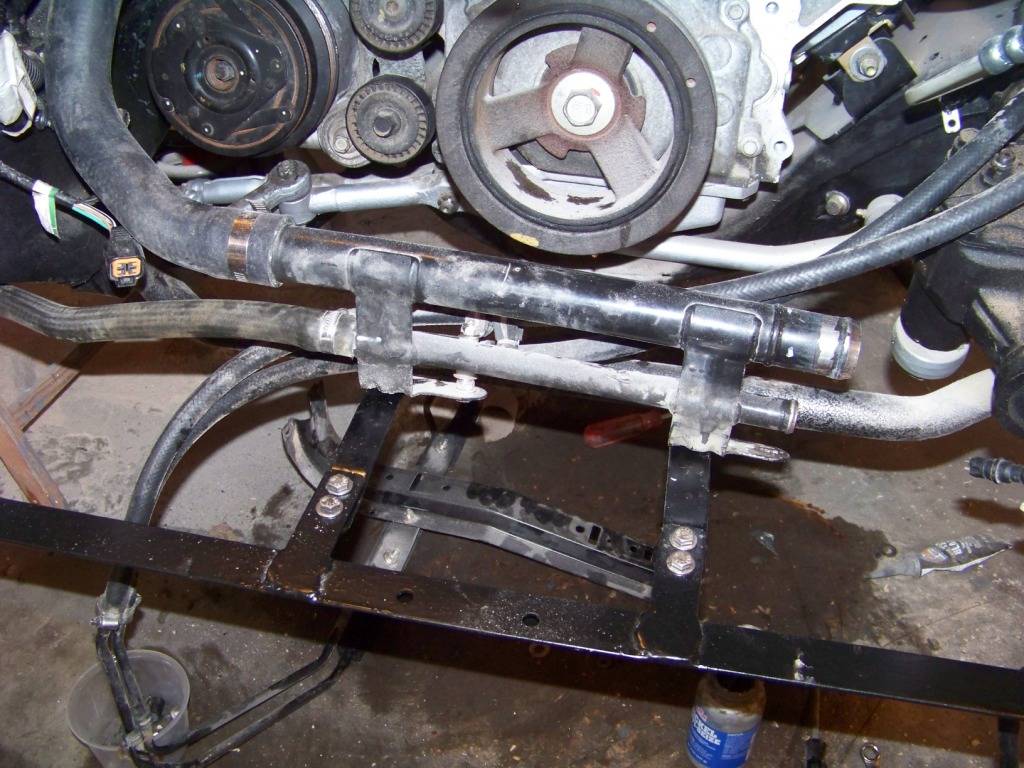
The coolant recovery tank was reinstalled in approximately the same position it was before except about 2 inches higher. The picture below shows the support brackets I fabricated and installed to support the tank. This is looking down into the area between the driver's side inner fender and the core support. The brackets are attached to the inner fender and core support. The bracket in the lower left corner of the picture is simple flat support the recovery tank rests on to support it.
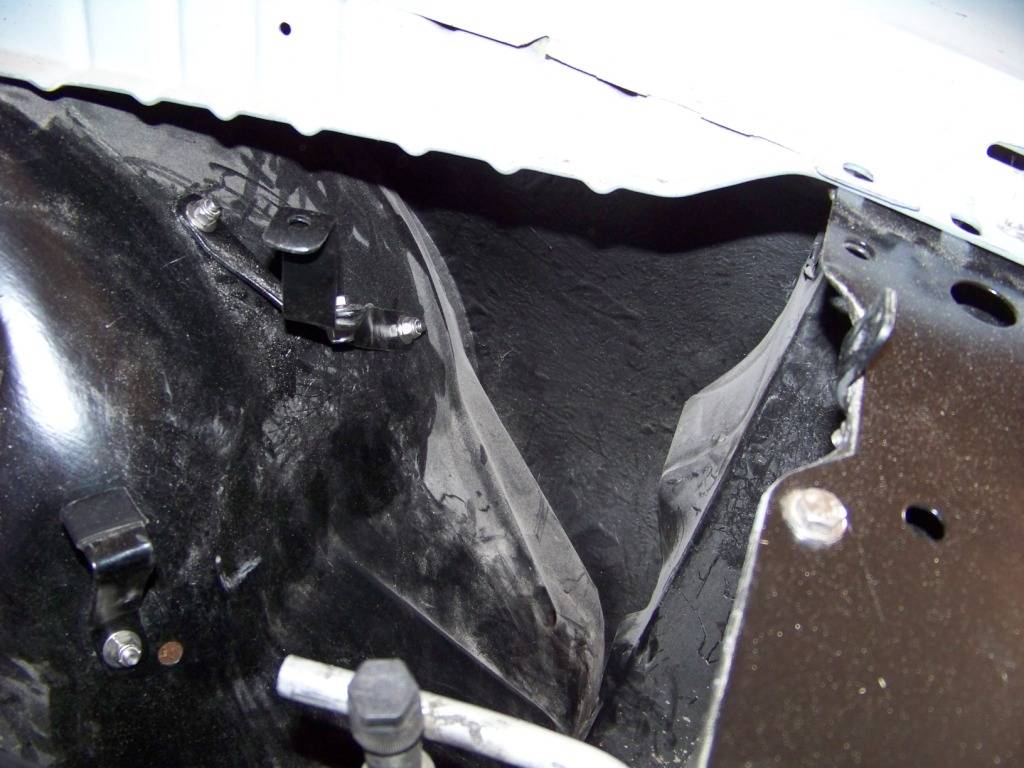
The following picture shows the recovery tank installed. The tank is now higher than the radiator and engine so the system should be filled correctly in the engine and radiator.
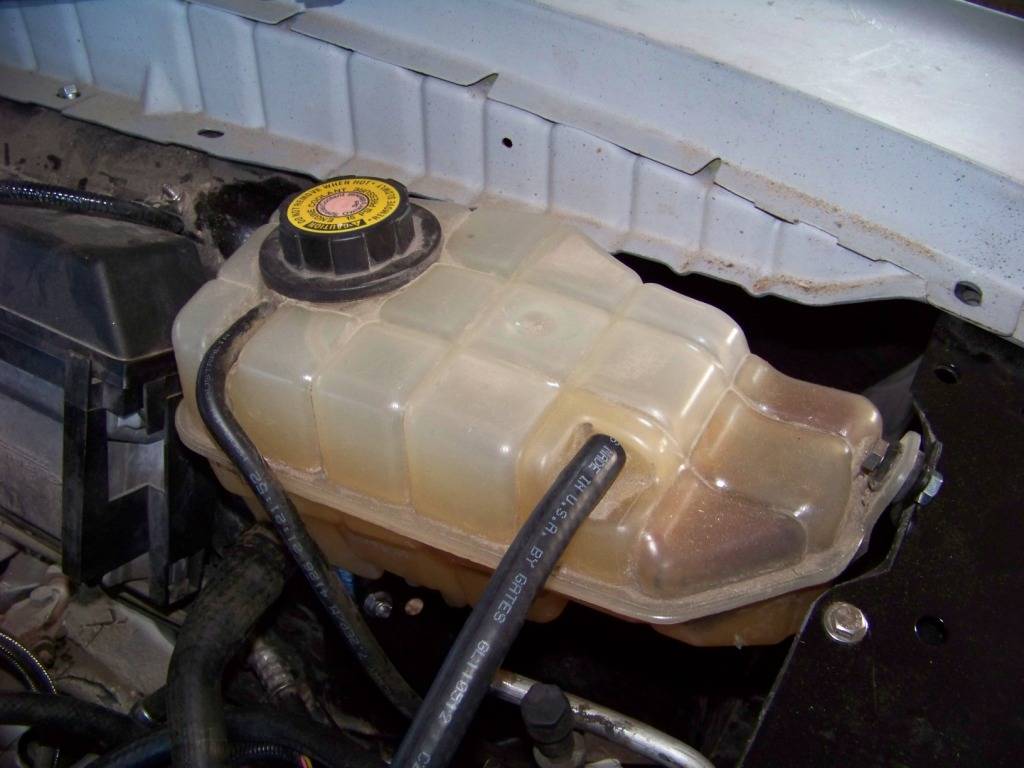
As part of this effort since the cooling system was drained I got the HVAC system installed in the interior and connected all of the heater hoses. I will document that in a future post.Last edited by fsdproject; 02-02-2013 at 08:38 AM. Reason: Added picture and text for coolant transfer tube supports
02-02-2013 #35 Registered User
Registered User
- Join Date
- Nov 2011
- Location
- Springfield, OH
- Posts
- 58
Firewall Interior Side Part One
I wanted to finish up the cooling system, which meant getting the HVAC system in, which meant getting the GTO's dash into the Lemans. But first I wanted to make sure everything needed was routed through or attached to the firewall, it's much easier to do before the dash goes in.
Brake Pedal
I used the brake pedal and support bracket from the Lemans. The only change I did here was to move the bracket a couple of inches rearward to accommodate the deeper size of the GTO dash. I just did this by using longer bolts and oversize nuts as spacers. The threaded rod from the brake booster was lengthened accordingly. I unfortunately did not take a picture of this. The GTO had two switches on the brake pedal, the Lemans had one. Interestingly, the main brake switch on the GTO appeared to be exactly the same as the one I took from the Lemans. I guess GM uses the same switch 30 plus years later. I did need to support both switches onto the Lemans' bracket, I just welded the lower portion of the GTO's brake switch bracket to the upper part of the Lemans. The pictures below show the modified bracket welded together and installed.
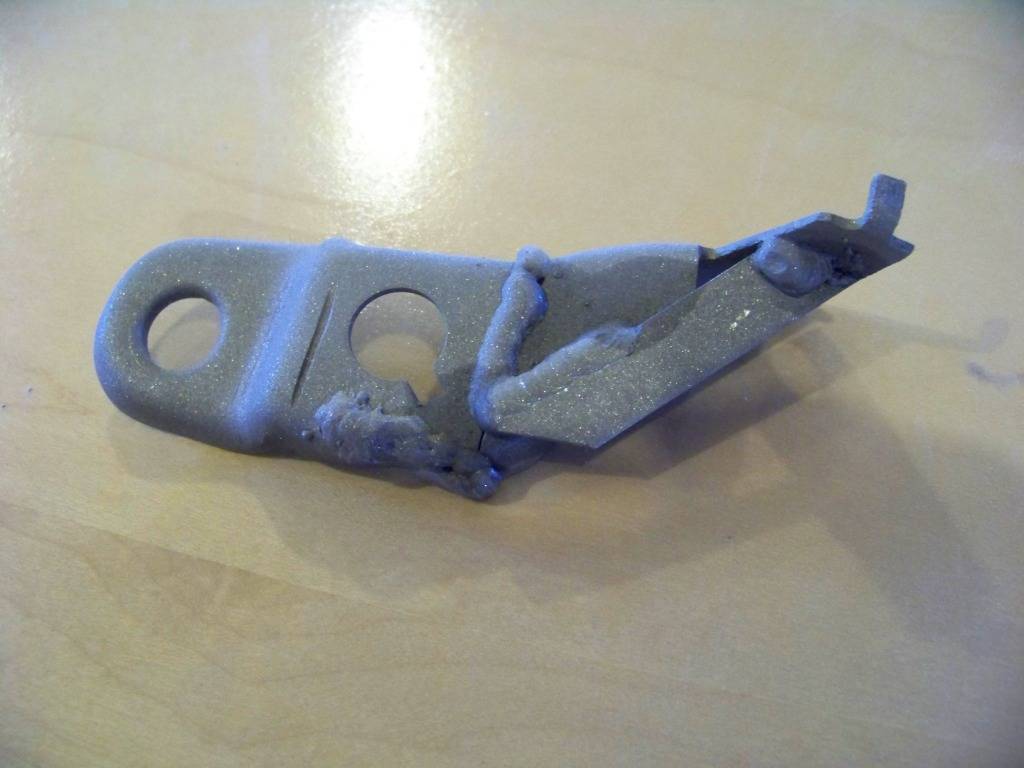
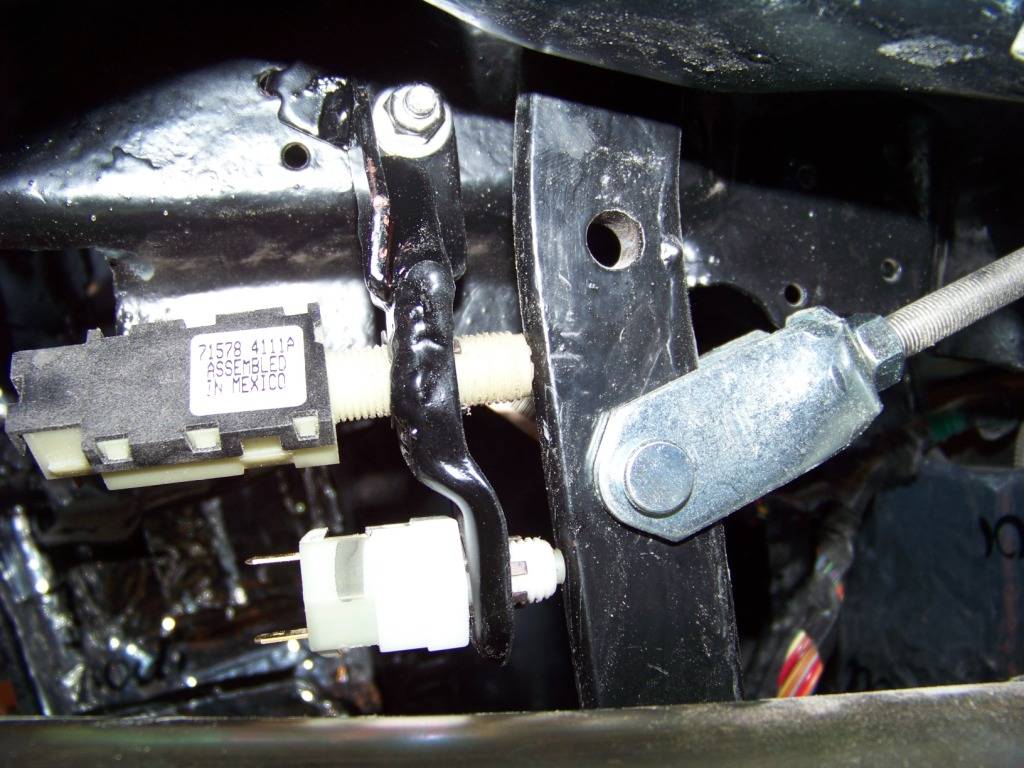
Gas Pedal
I wanted to use the GTO's gas pedal assembly because it was already designed to work with the throttle cable from the engine. The picture below shows how the gas pedal assembly attached to the GTO's firewall. I needed the round opening in the firewall above the bracket to support the cable end so I cut that portion out as shown.
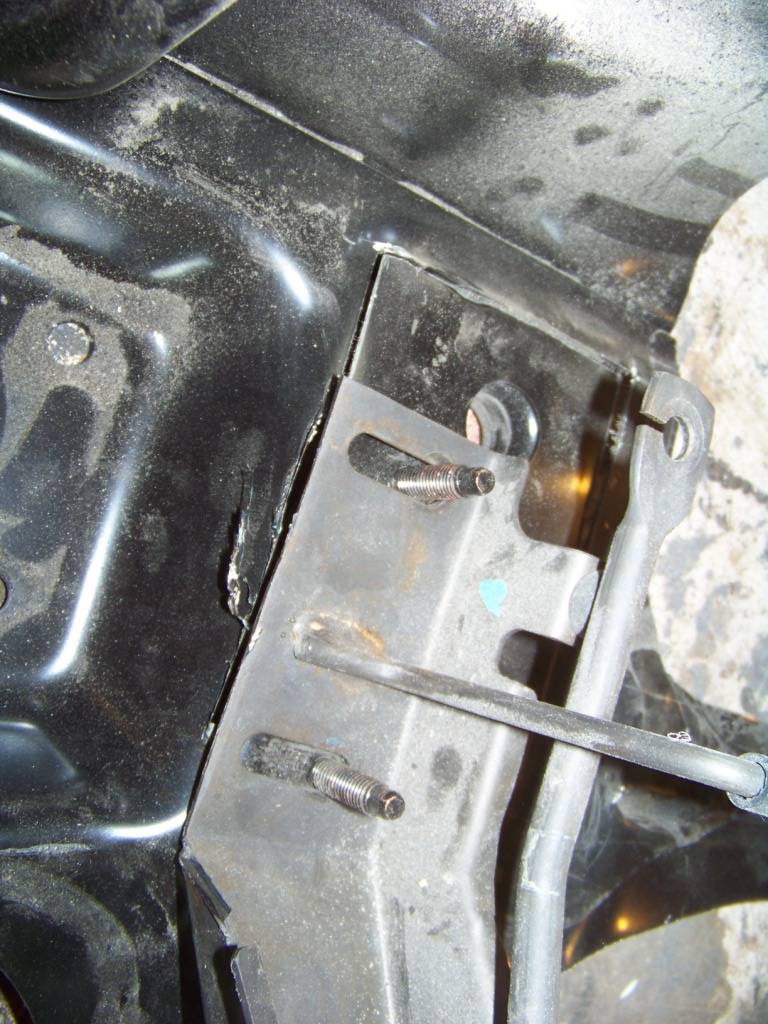
The assembly of the firewall section and the gas pedal assembly was bolted to the firewall in the appropriate place. I added the black bracket as shown to support the lower portion of the pedal assembly. I also thought the gas pedal was too low so I created a new one from welded steel with the pivot point towards the bottom instead of the middle, although I may go back to the GTO's pedal as a play around with things in the interior. In the upper right corner of this picture you also can see how I spaced the brake pedal bracket from the firewall.
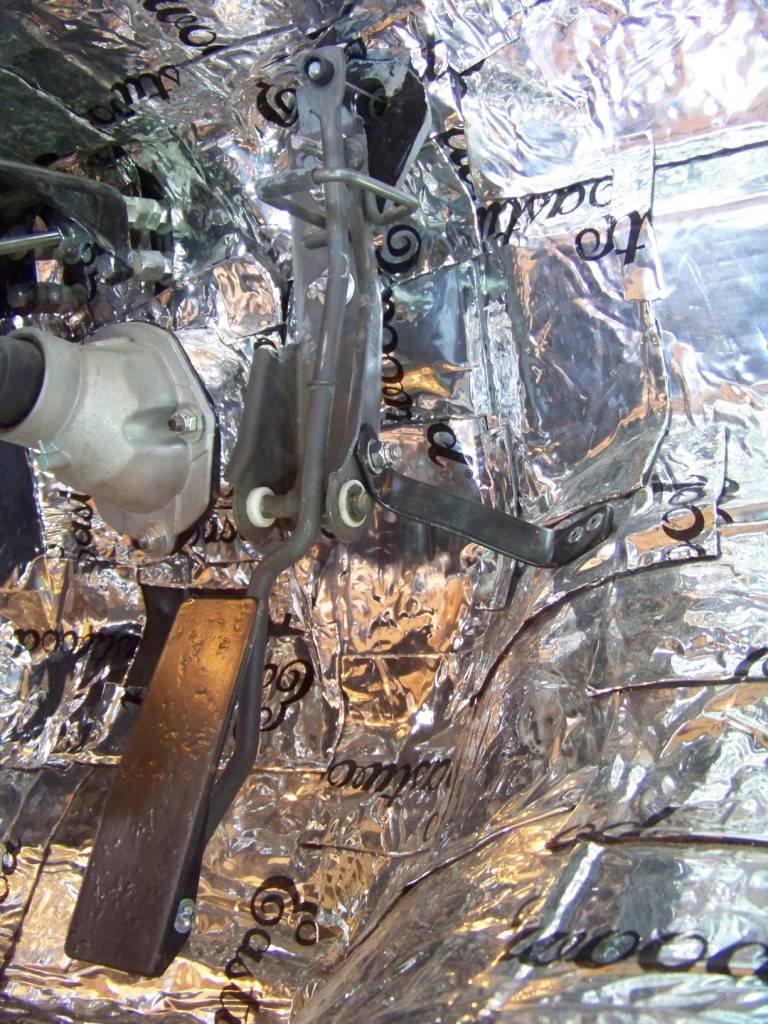
I drilled a 1" dia hole in the Lemans' firewall for the cable end support from the GTO firewall. The picture below shows that on the forward side of the firewall.
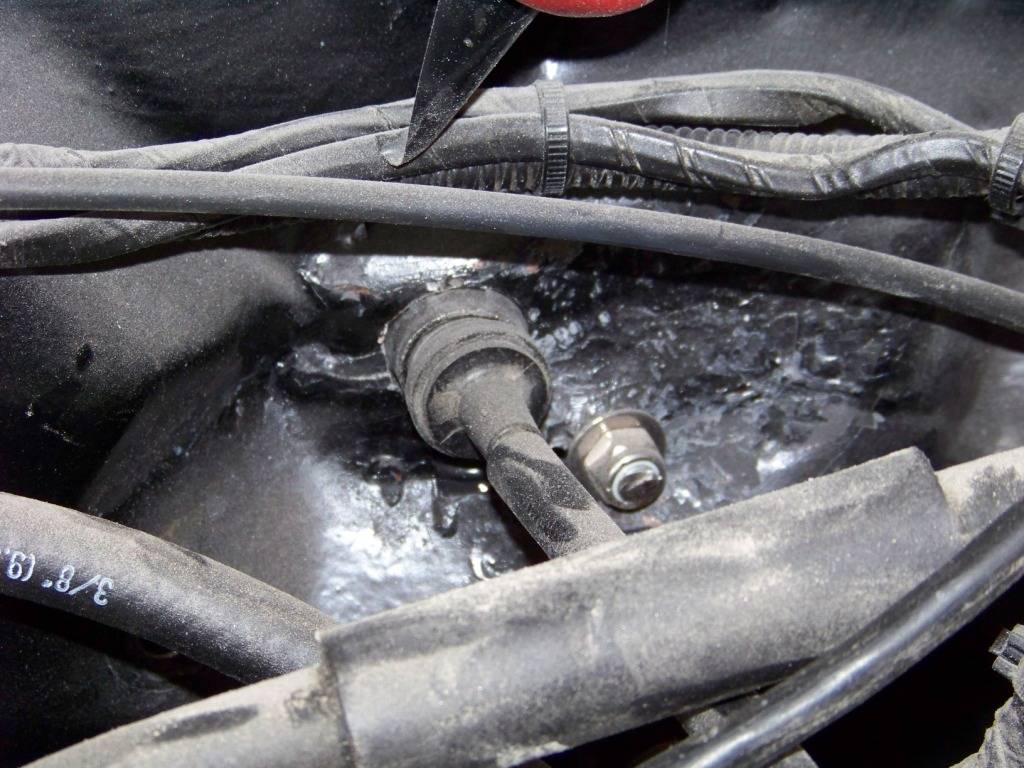
Cowl Vent Covers
Since the GTO's HVAC takes fresh air from the upper cowl area, these large openings in the lower sides on the cowl are no longer needed. I made up some simple sheet metal covers and riveted them and sealed them in place on both sides. These were then covered up with sound deadener material.
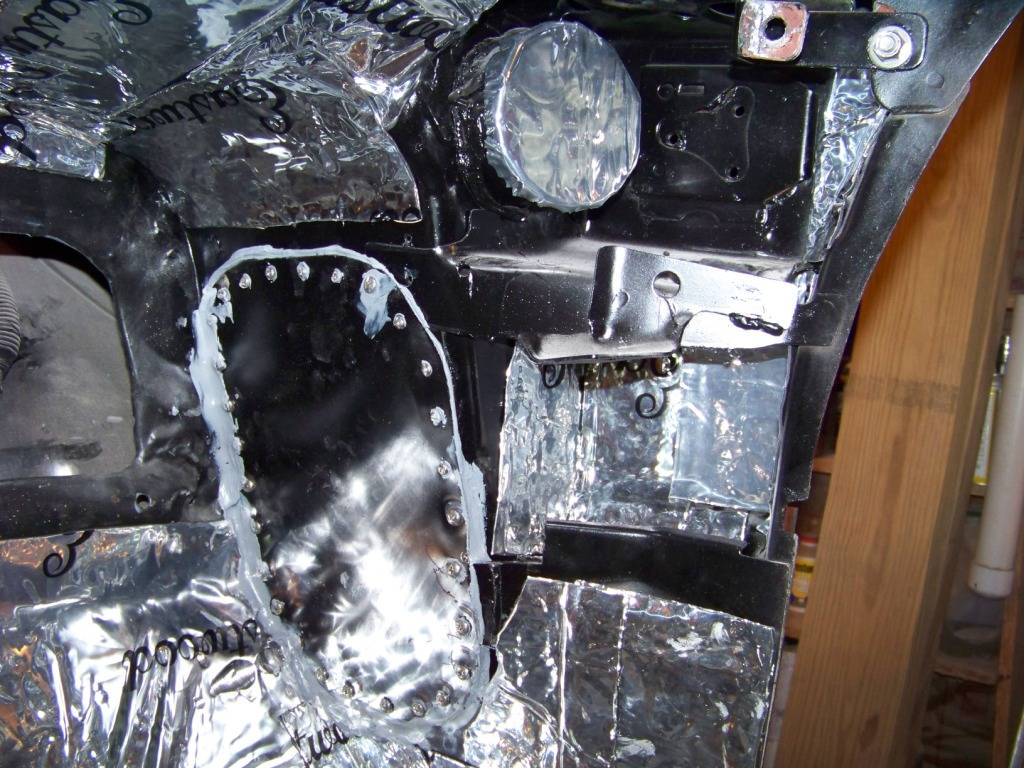
BCM Installation
On the GTO the BCM is installed on the interior side of the cowl pasenger side, I did the same. I did a similar thing on the driver's side with the throttle control module. The pictures below shows adding brackets to the BCM, then the BCM attached with sheet metal screws through the new brackets to the cowl cover plates discussed above.
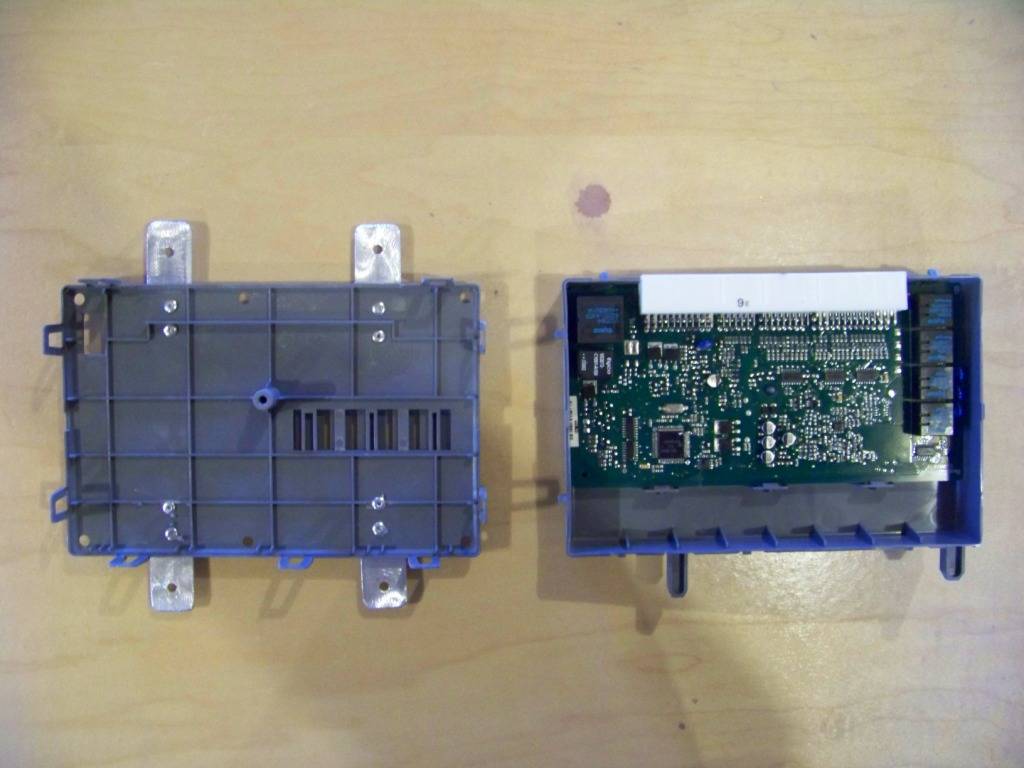
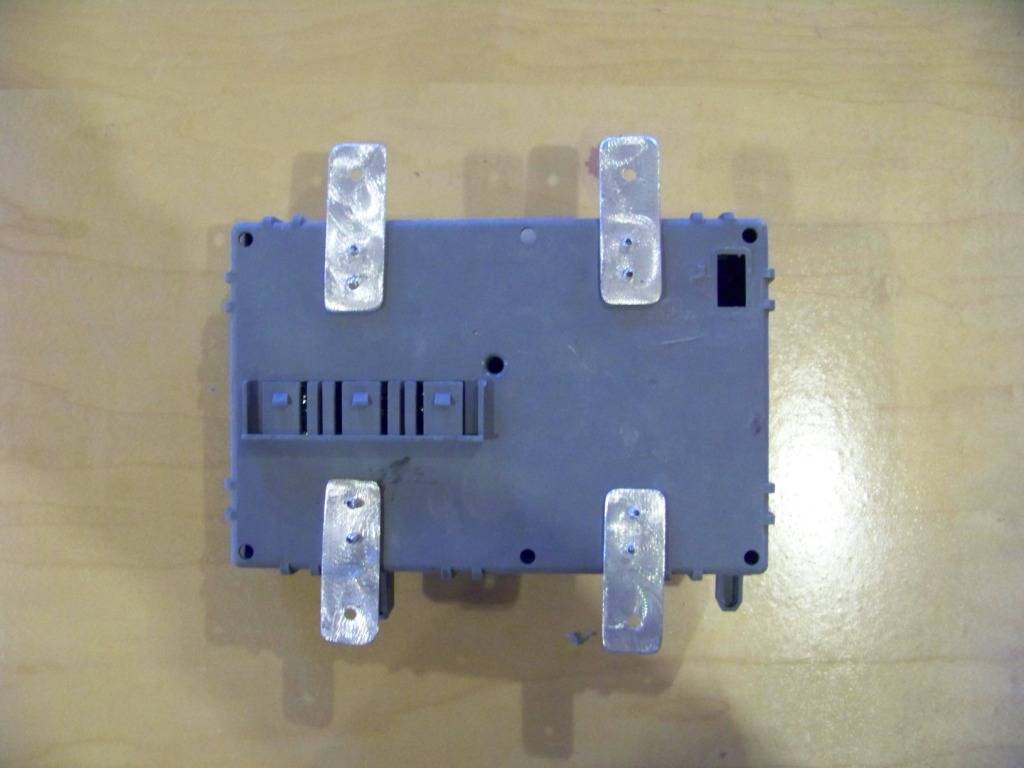
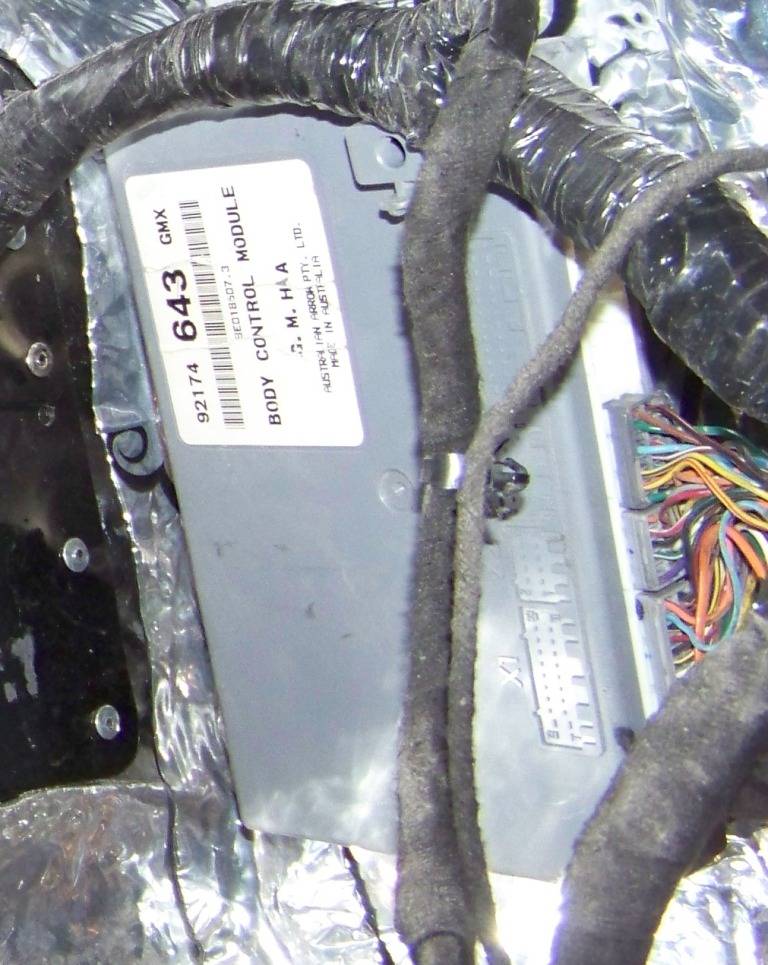
Firewall Part Two will cover wire bundle and HVAC routing through the firewall.
02-02-2013 #36 Registered User
Registered User
- Join Date
- Nov 2011
- Location
- Springfield, OH
- Posts
- 58
Firewall Interior Side Part Two
I then needed to get two wire bundles and four HVAC connections through the firewall.
Driver's side wire bundle
A smaller wire bundle from the GTO donor goes from under the hood to the dash area on the driver's side. I used the existing rectangular hole in the firewall that was originally used for the fuse block and connection to the Lemans' wire bundle. I needed to find a way to seal the opening around the existing hole. There are existing split seals available, but they didn't really work well for this situation. I did use their design concept in what I came up with.
I made a two-piece cover that could be installed around the wire bundle which was already routed, I didn't want to remove all of the connectors just to route it through a grommet. The cover is made from sheet metal, the grommet is just an appropriately sized rubber grommet I got from Lowes. I cut the grommet in half and put each half into each half of the cover plates. The two plates overlap each other in the middle to sandwich the grommet halves together.
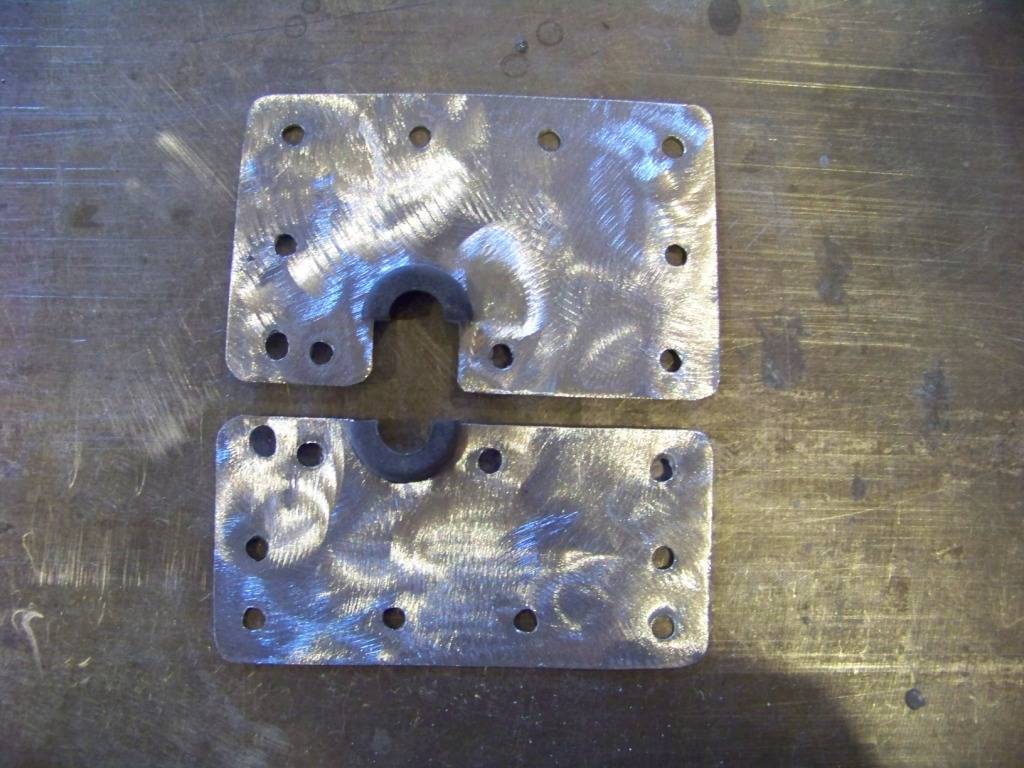
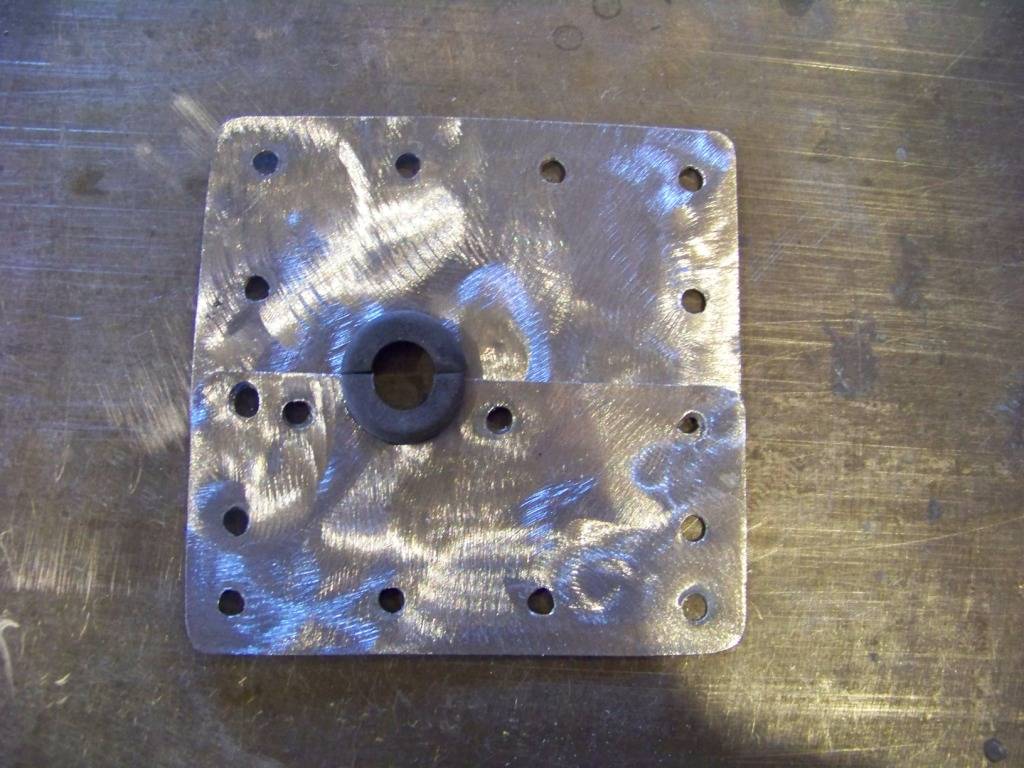
This picture shows the plate/grommet assembly installed from the front of the firewall. The plates are attached to each other and to the firewall with 3/16" steel rivets, the plate will be sealed with seam sealer on the outside and covered with sound deadener on the inside.
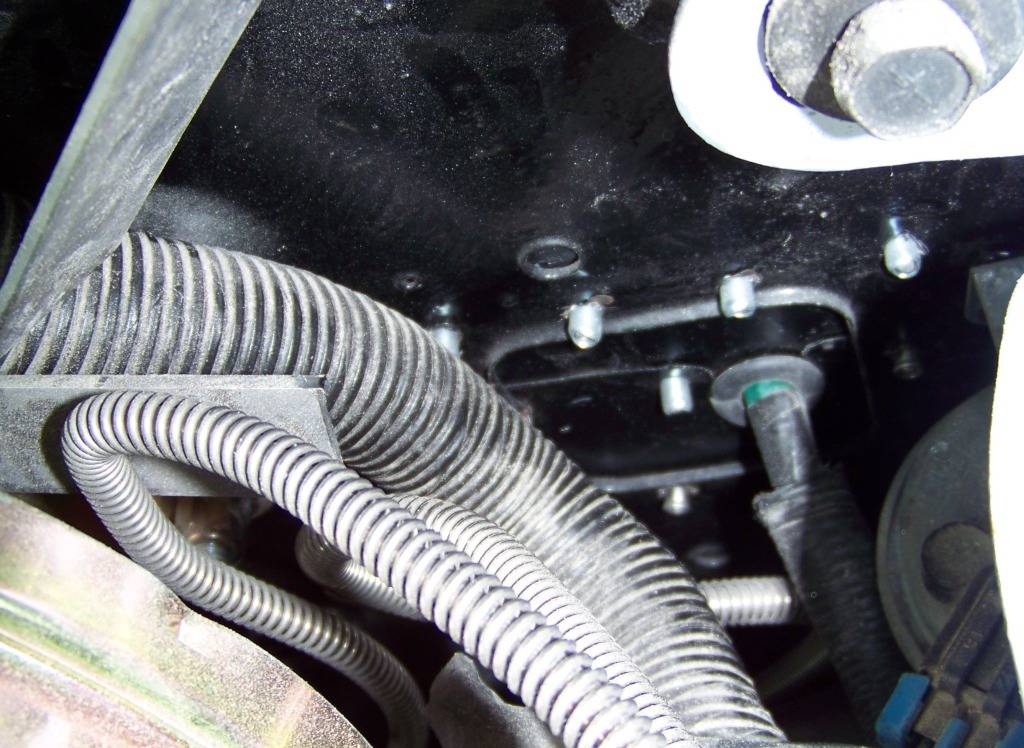
Passenger Side Bundle and HVAC bulkhead connections
On the passenger side I had a similar situation with the larger bundle on that side, plus I needed to provide for the AC and heater connections. I also had the large rectangular hole in the firewall from where the heater core used to be to cover. I took care of all of these issues with a another two-piece cover plate that also had holes for the AC and heater bulkhead connectors. The picture below shows the two parts of the plate and the grommet I cut in half. The grommet is from McMaster, part number 6359K35. Lowes did not have a grommet this large.
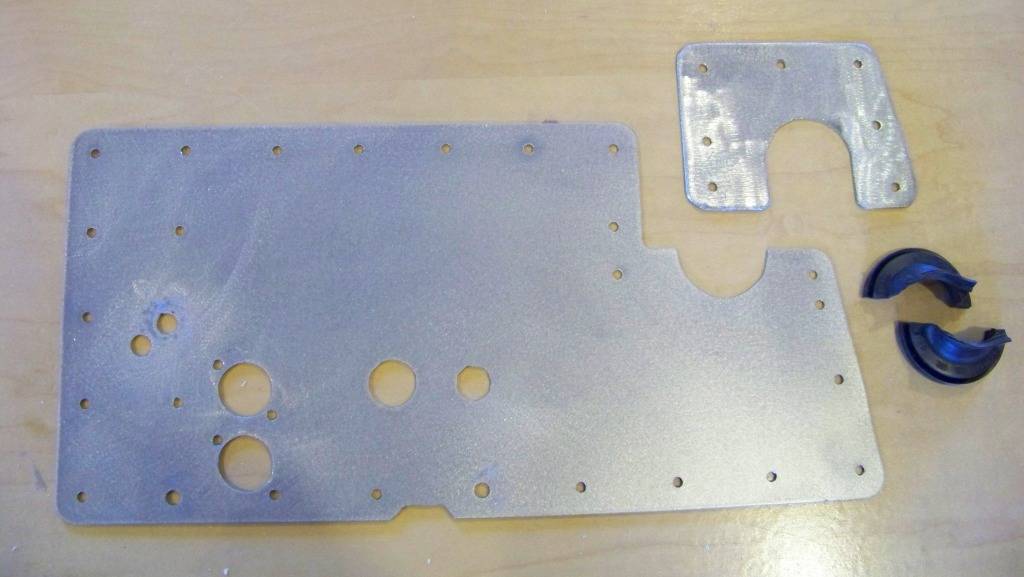
In the above picture the two small holes in the left side of the plate are for vacuum lines between the HVAC unit in the interior and engine and heater valve under the hood. The vacuum lines will be routed through these holes with rubber grommets. The two larger holes positioned vertically are for the heater bulkhead fittings and the remaining two holes to the right are for the AC bulkhead fittings.
The next picture shows the plate installed around the passenger side wire bundle. The plate was installed with 3/16" steel rivets. The following picture shows a close up of the wire bundle area. Again, the plates overlap to sandwich and hold the two halves of the grommet in place around the bundle.
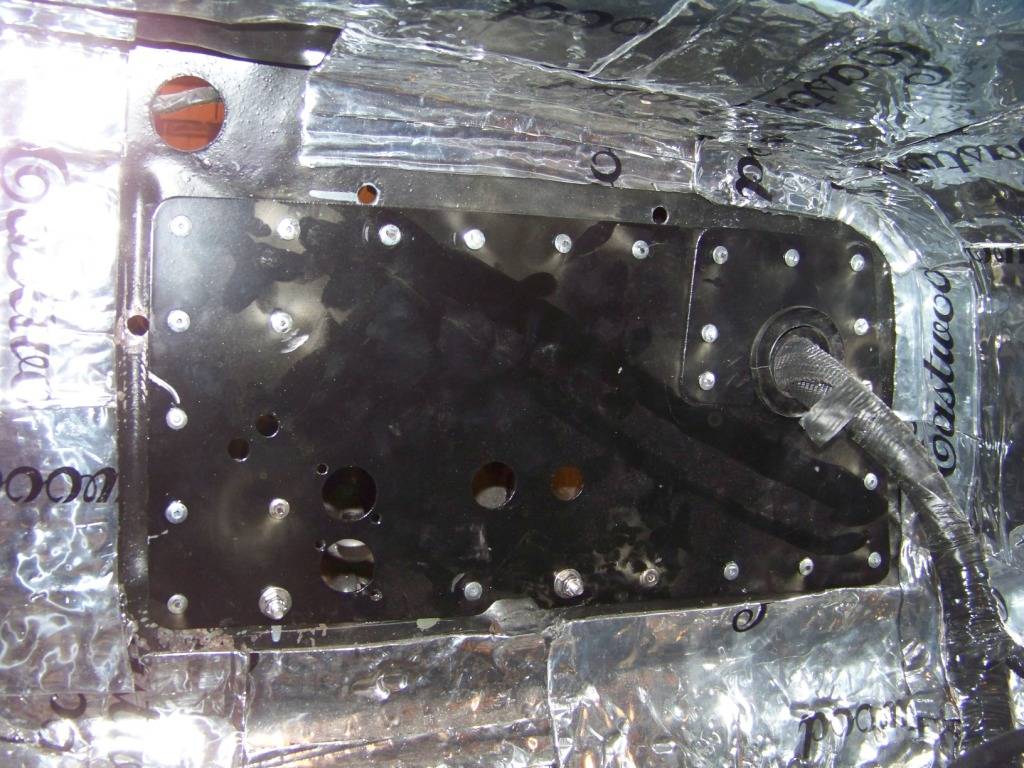
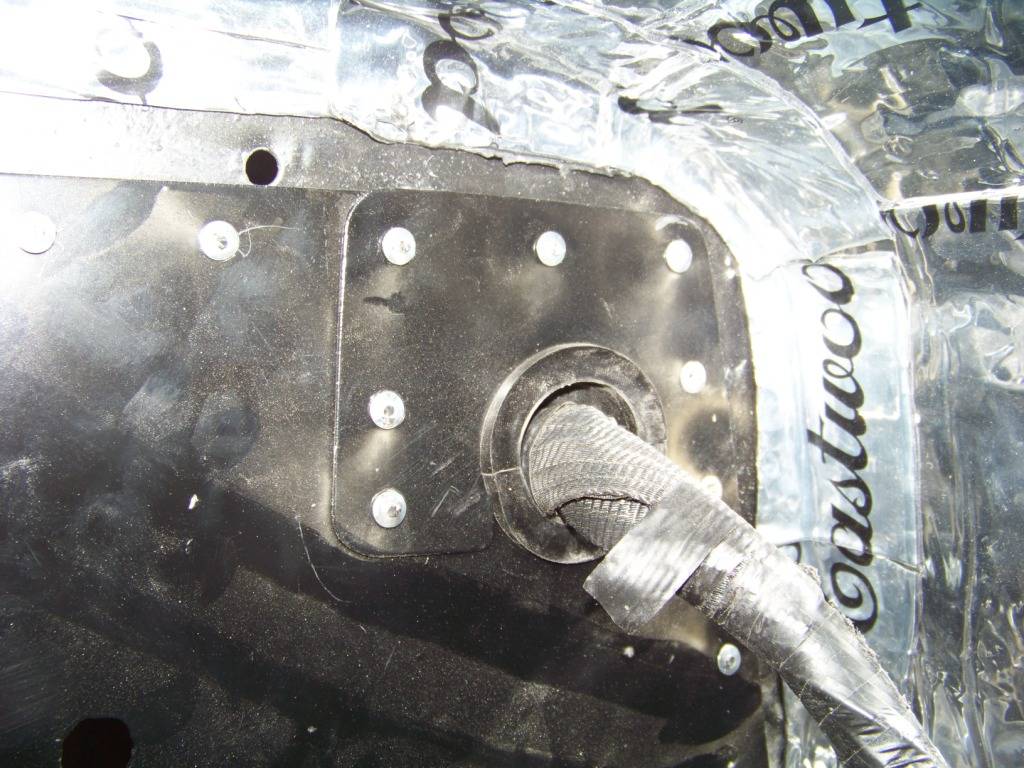
The HVAC unit from the GTO will sit about 4 inches behind the Lemans' firewall. So I needed some short heater hose connections in the interior side between the HVAC unit and the firewall cover plate. Since there were going to be hose connections on both sides I needed heater bulkhead fittings that had barbed ends on each side. I searched extensively online but could not find anything like that, so I made my own. The picture below shows the parts I used. Each fitting is made from a 1/2 inch pipe nipple, large washer to fit around the pipe nipple, a 1/2 inch pipe elbow and two barb fittings as shown. The pipe parts and washer are from Lowes, the barb fittings came from McMaster. They are part numbers 5346K59 and 5346K66. The washer was welded to the pipe nipple and had two holes to facilitate bolting the fitting the the firewall.
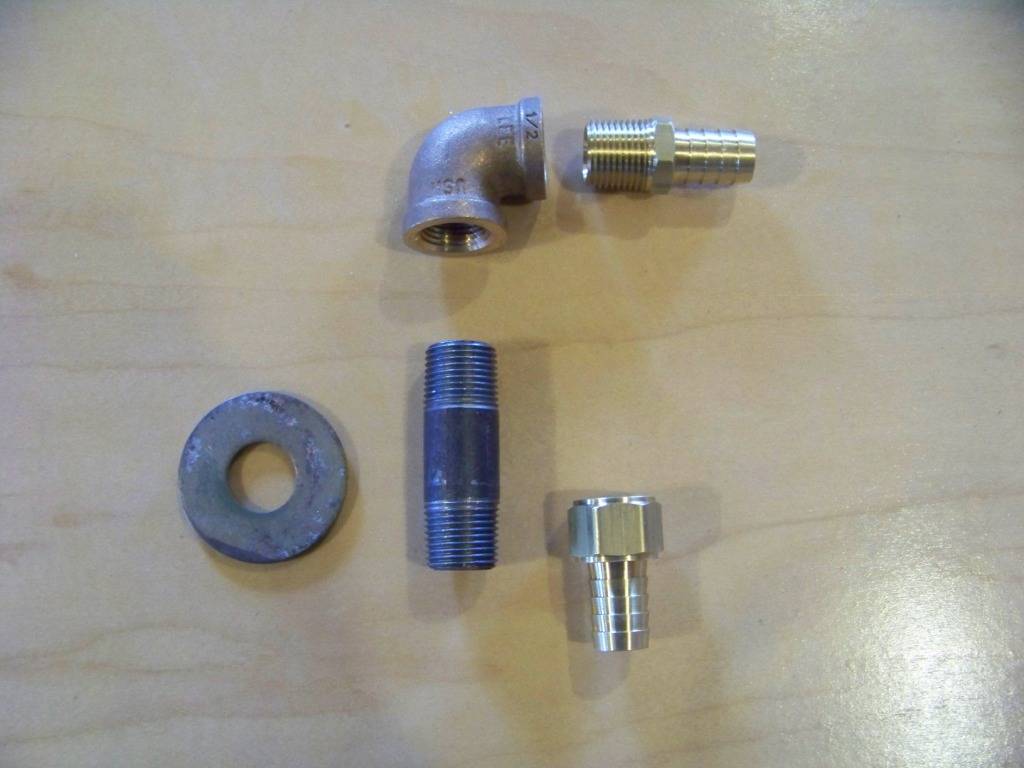
The following picture shows the heater and AC bulkhead fittings installed onto the plate.
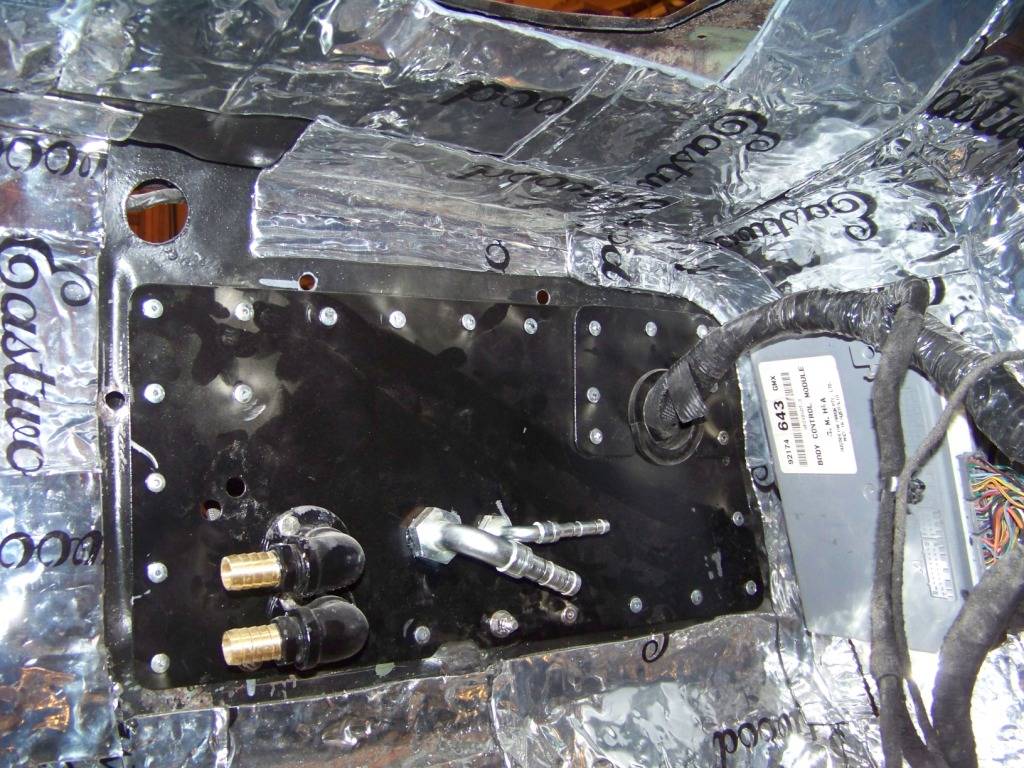
I did my usual research into AC hoses and fittings and found that there is quite a few ways to go. I stumbled upon the EZ-Clip fittings from Aeroquip and liked them because they are easy for a home builder to make and install. The only special tool required is a pliers. Aeroquip sells the pliers for about $50, but amazingly I found the pliers along with many of the fittings I needed on Ebay for $5 each. I will talk about the AC hoses in a future post but I will give the part numbers for these bulkhead fittings here: FJ3514-0606S and FJ3514-1010S.
When I tried to install the interior heater hose connections I found that I placed the holes in the bulkhead too low, even after what I thought was good measuring and pondering. The fittings were moved up one hole, with another hole being drilled into the plate and the lower hole covered up. They were also rotated about 30 degrees up from vertical. In a future post I will try to show this connection, but it's tough to take pictures under the dash.
02-02-2013 #37
02-04-2013 #38 Registered User
Registered User
- Join Date
- Nov 2011
- Location
- Springfield, OH
- Posts
- 58
2004 GTO Interior Ė Steering
This post will show installing the steering column from the GTO donor into the Lemans. I wanted to get the steering column installation figured out before the dash in went because the area is easier to get access to.
I had previously mocked up where I wanted to dash to go, so I knew about how far rearward the column needed to be to mate up with the relocated dash supporting structure.
I have seen different ways to do this on other builds but either I didnít care for what was done in the past or it wouldnít work in my situation. I didnít want to modify steering parts with welding and cutting on the column and linkage parts. I wanted a bolt together solution that was safe and secure.
The main issue of this installation is supporting the column at the Lemans firewall. I first thought about using the column mount on the GTO firewall that was installed to support the dash, but it didnít seem secure enough, and I still had the issue with sealing the opening through the Lemans firewall where the steering shaft passes through. So I made an adapter that mounts the GTO donor column to the Lemans firewall. Itís basically two plates connected by a sheet metal ďtunnelĒ that the steering shaft passes through. One plate attaches to the Lemans firewall, the other bolts to the bottom of the GTO column. The description and pictures below describe the process.
The picture below shows the steering column closeout plate for the firewall of the Lemans. I removed the column clamp brackets as shown.
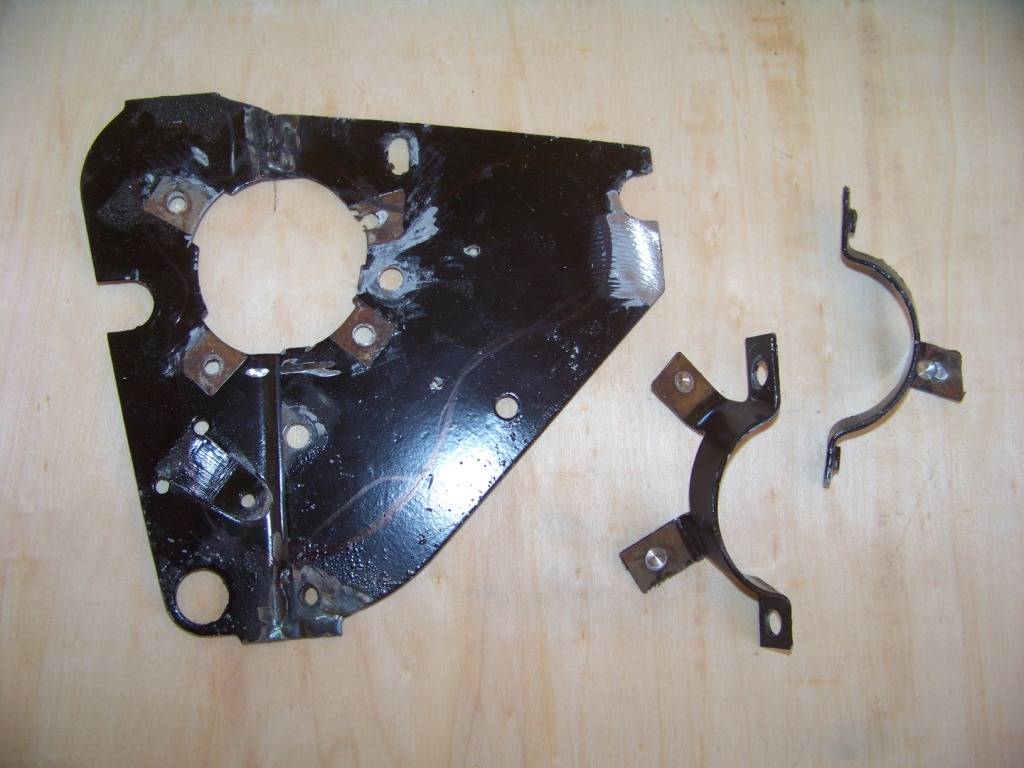
The picture below shows the bottom on the GTO column where it attaches to the GTO firewall:
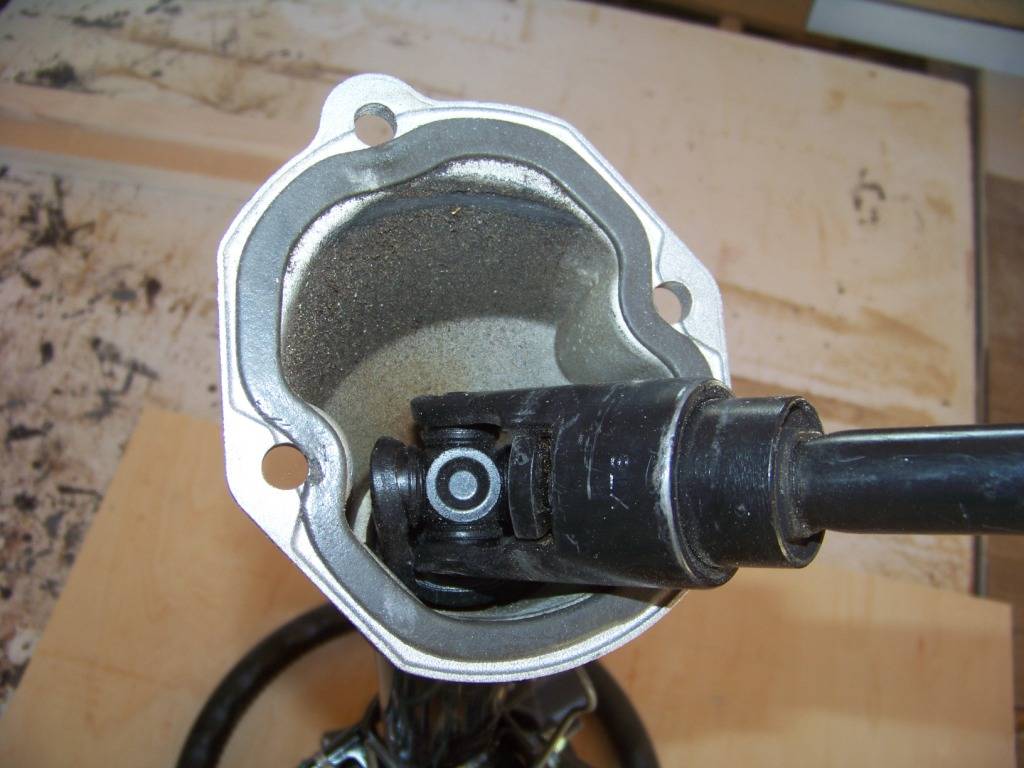
The next couple of pictures show the plate I made to support the bottom of the GTO column:
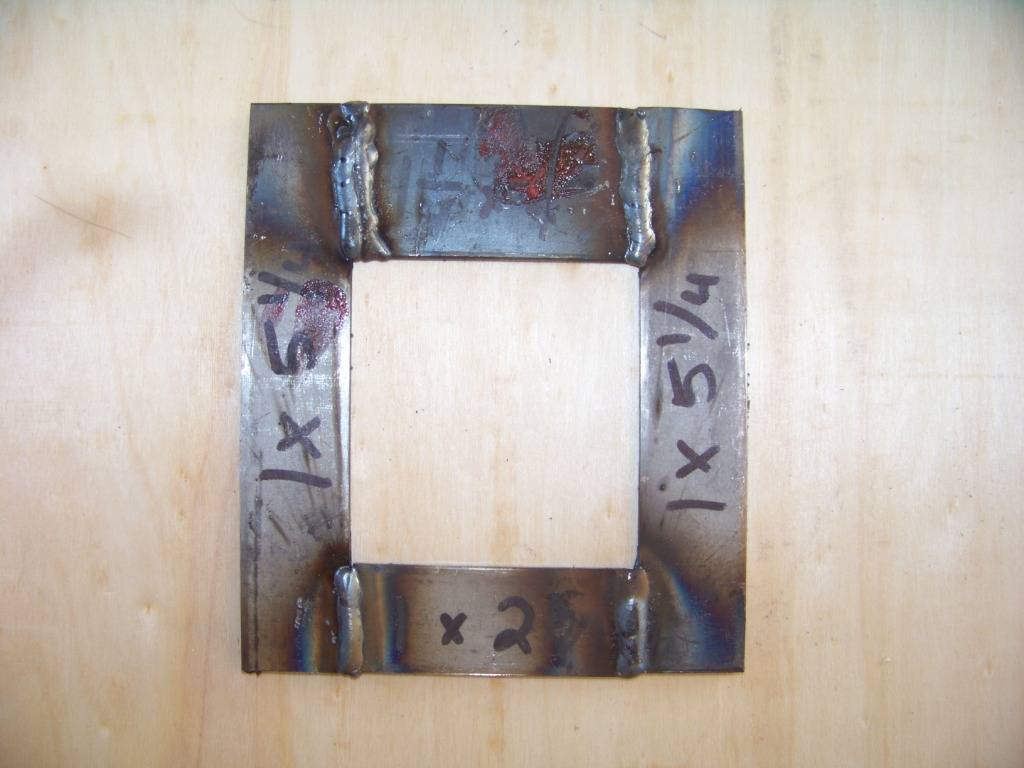
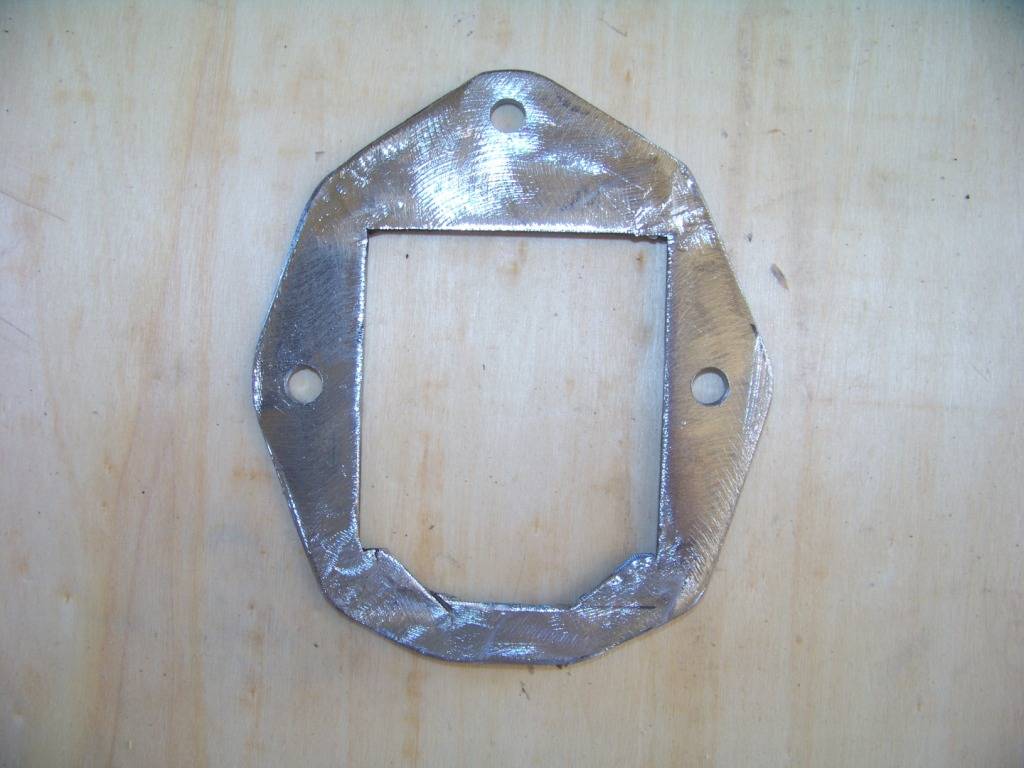
The pictures below show the construction of the whole column adapter assembly.
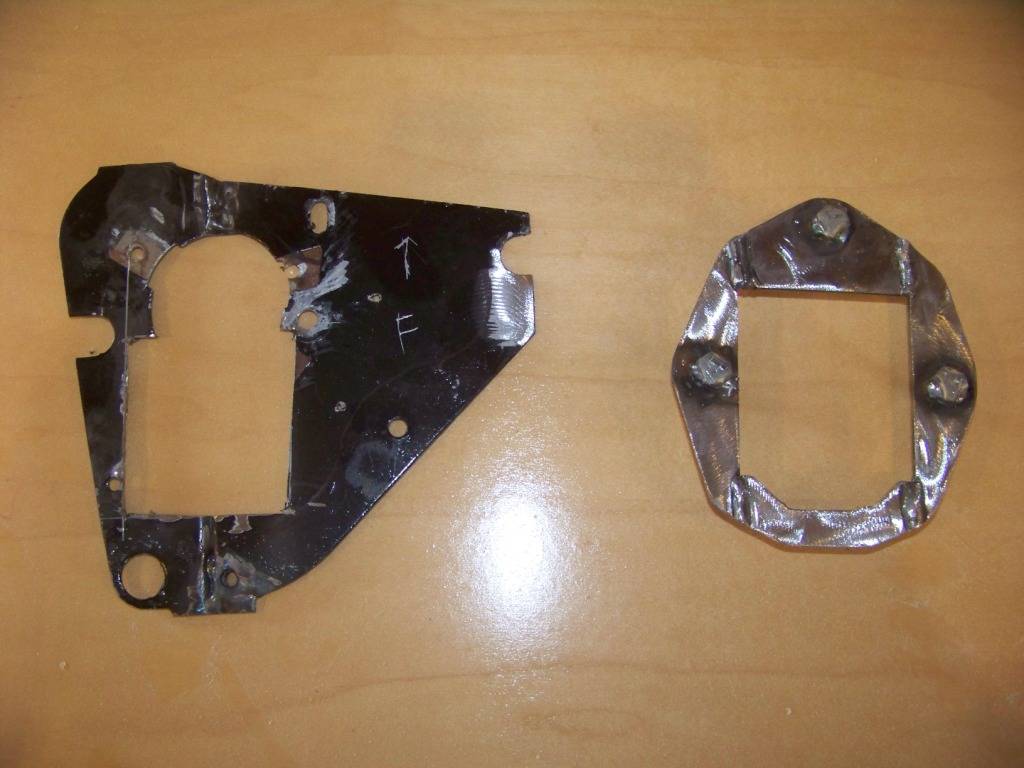
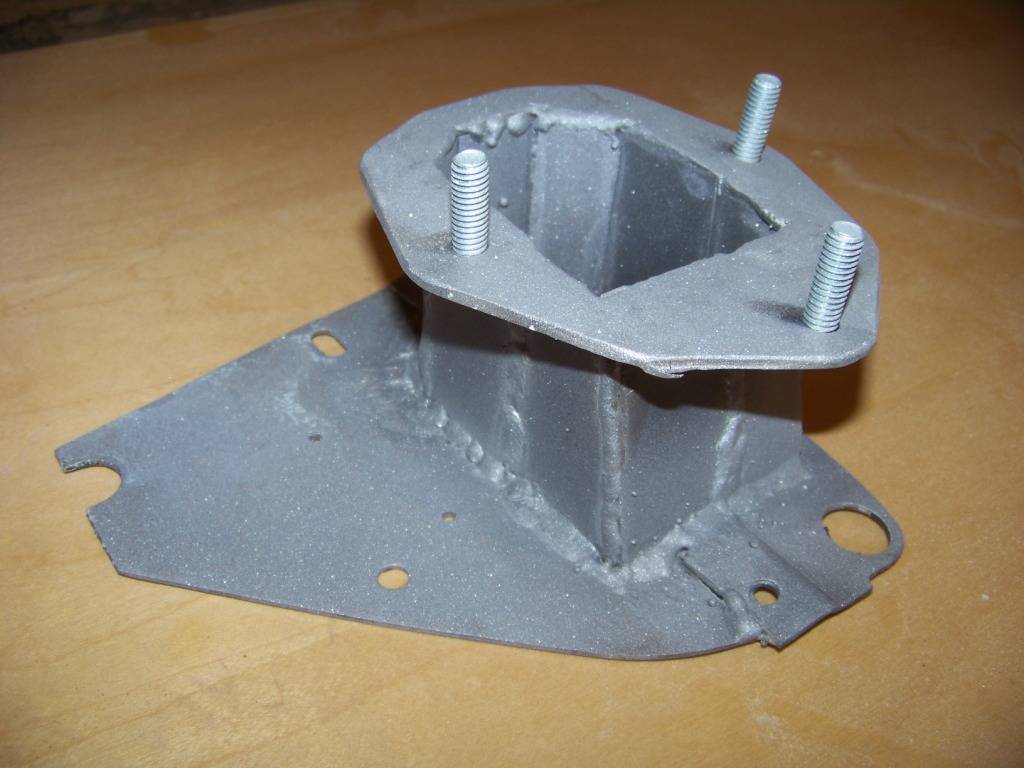
The next two pictures how the steering column adapter assembly installed with the GTO steering column bolted to it.
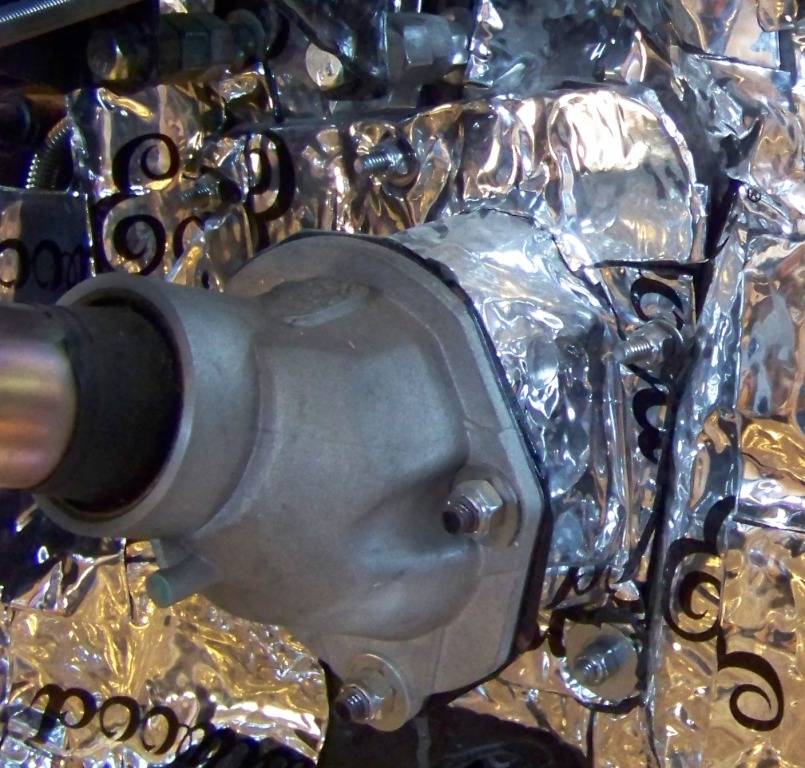
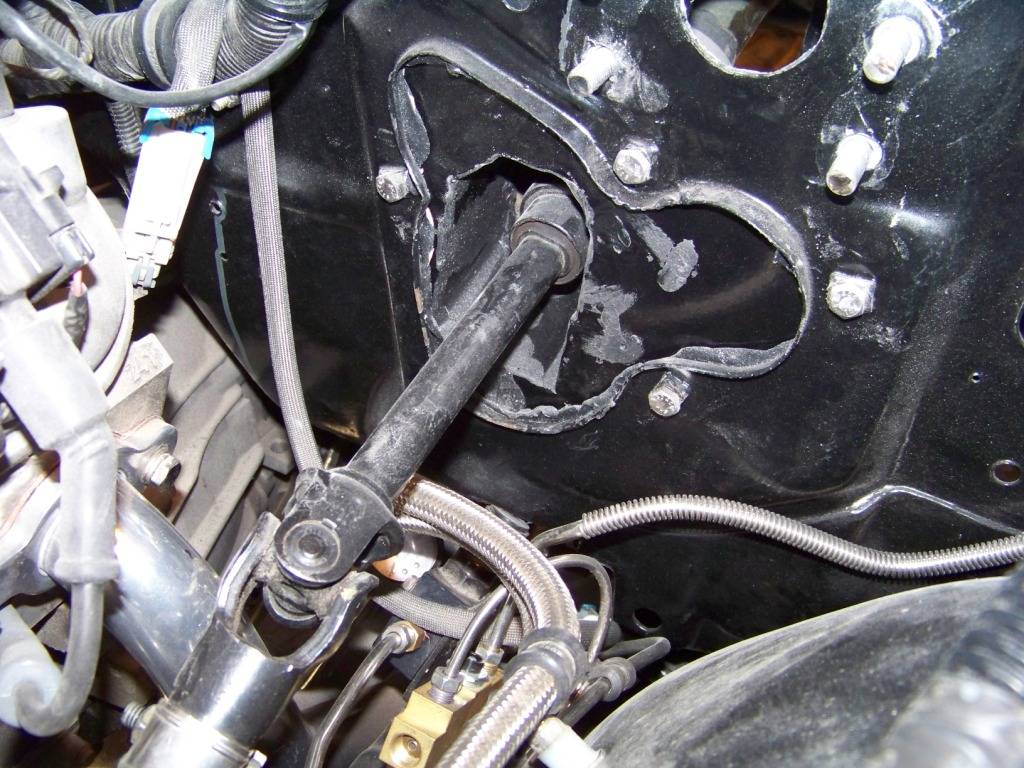
Now that the column is mounted, I could connect the GTO's steering column shaft to the steering gearbox. The bottom of the GTO donor column connected to the GTO steering rack with a ĺĒ DD connection. The shaft on the Jeep Cherokee steering gearbox is ĺĒ diameter, 30 spline with a flat. I bought the following parts to connect the two together:
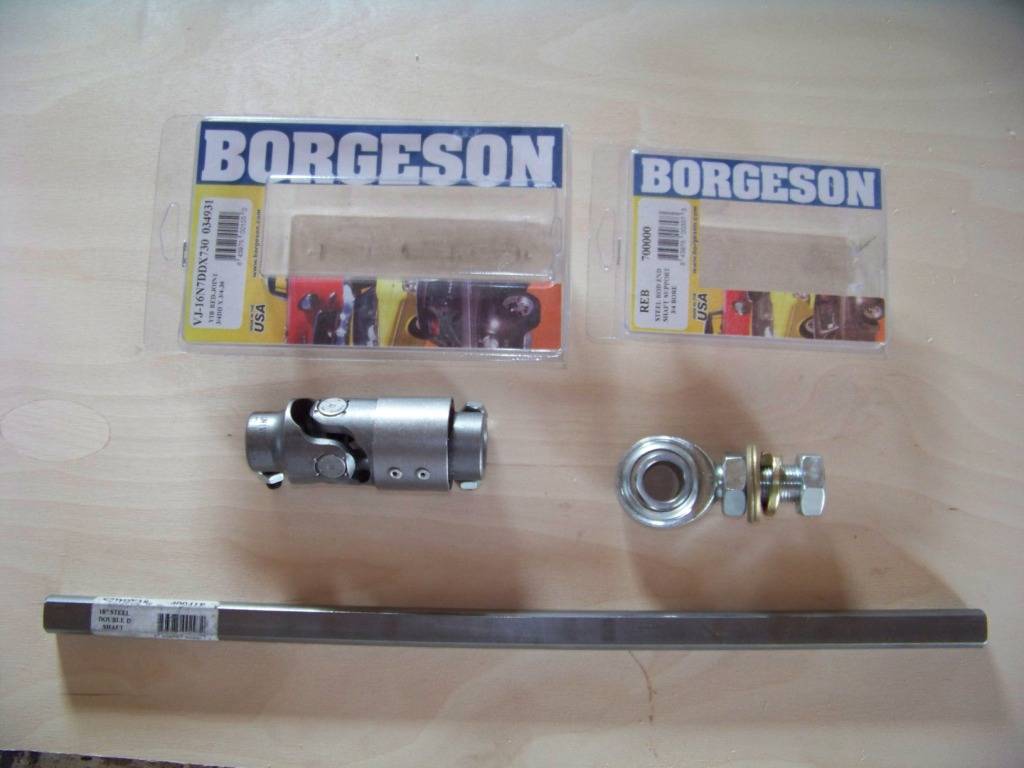
Parts are all from Borgensen; BRG-034931 u-joint, BRG-409418 Steering Shaft, and BRG-700000 3/4" support bearing.
The coupler installed onto the steering gearbox and allowed for a connection to the ĺĒ DD shaft which was trimmed to length. This then connected to the ĺĒ DD opening at the bottom of the GTO column (in black in the picture below). Not shown here but there is another universal joint higher up in the GTO column. Since this steering connection has a total of three universal joints, an intermediate shaft support is required as shown below the middle connection. This shaft support is then supported by bracket I fabricated and installed on the rear upper control arm bolt. The bracket is shown below.
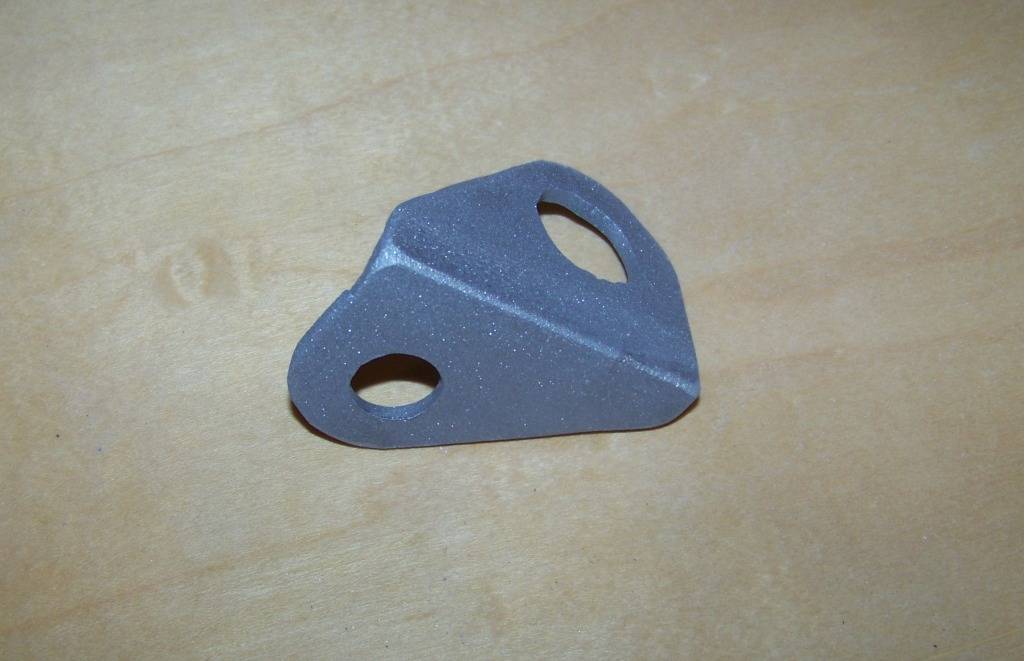
All the above parts installed as shown below.

Please feel free to ask any questions if any of this is unclear.
02-04-2013 #39Holy cow awsome stuff.
Maybe I missed it but what did you use for the fuel system?
Are you going to keep the cruise control?
With the GTO steering in place any thoughts on how you will make things like the blinker and hazzards work?
What else is on the GTO steering wheel?Some times I'm fast sometimes I'm half-fast
02-05-2013 #40 Registered User
Registered User
- Join Date
- Nov 2011
- Location
- Springfield, OH
- Posts
- 58
rohrt:
Thanks for your comments!
For the fuel system so far I have run the standard a-body fuel line along the frame rail up to the fuel rail of the LS1 with a fuel pressure gauge and AN lines and fittings so that's all set. Over the last couple of weeks I have been fussing around with the 04 GTO tank and I think I have a good plan to use that. This keeps in with my theme of using as many of the GTO's components as possible and keeping it plug and play. Just bought some materials yesterday to make that happen and hope to have a post documenting it in the near future. The GTO donor tank actually sits petty well in the forward part of the trunk directly below the panel between the rear window and trunk opening. I cannot put it over the rear axle as it is on the new GTO because that's where the top goes down into. This does impact trunk space somewhat, but I am also thinking of mounting the donor GTO's spare tire and evap canister under the trunk where the original a-body tank used to be so I think this should get me a better usable trunk space anyway instead of having the spare in the middle of the trunk floor as it normally is in an a-body.
I am keeping the cruise control, all the electrical components and wiring harness from the 04 GTO were brought over and plugged back in, so that was easy. See post #24 for the mounting of the cruise components under the hood. The GTO's entire dash and steering column controls are also being used so all of that just plugs back together.
For the blinkers and hazards and other exterior lights I believe the only thing I have to do is splice some new pigtails (intended for a 71 Lemans) for all of the Lemans' exterior lights into the GTO's wire harness.
There are radio controls on the GTO steering wheel, since I am bringing everything over including the original stereo and plugging it back in it should work as intended. Even the airbags should work.
About the only thing electrically I won't have from the GTO donor is the ABS, but I may try to add that in the future.
Thanks, let me know if you or anyone else has any questions.
Phil




 Reply With Quote
Reply With Quote






